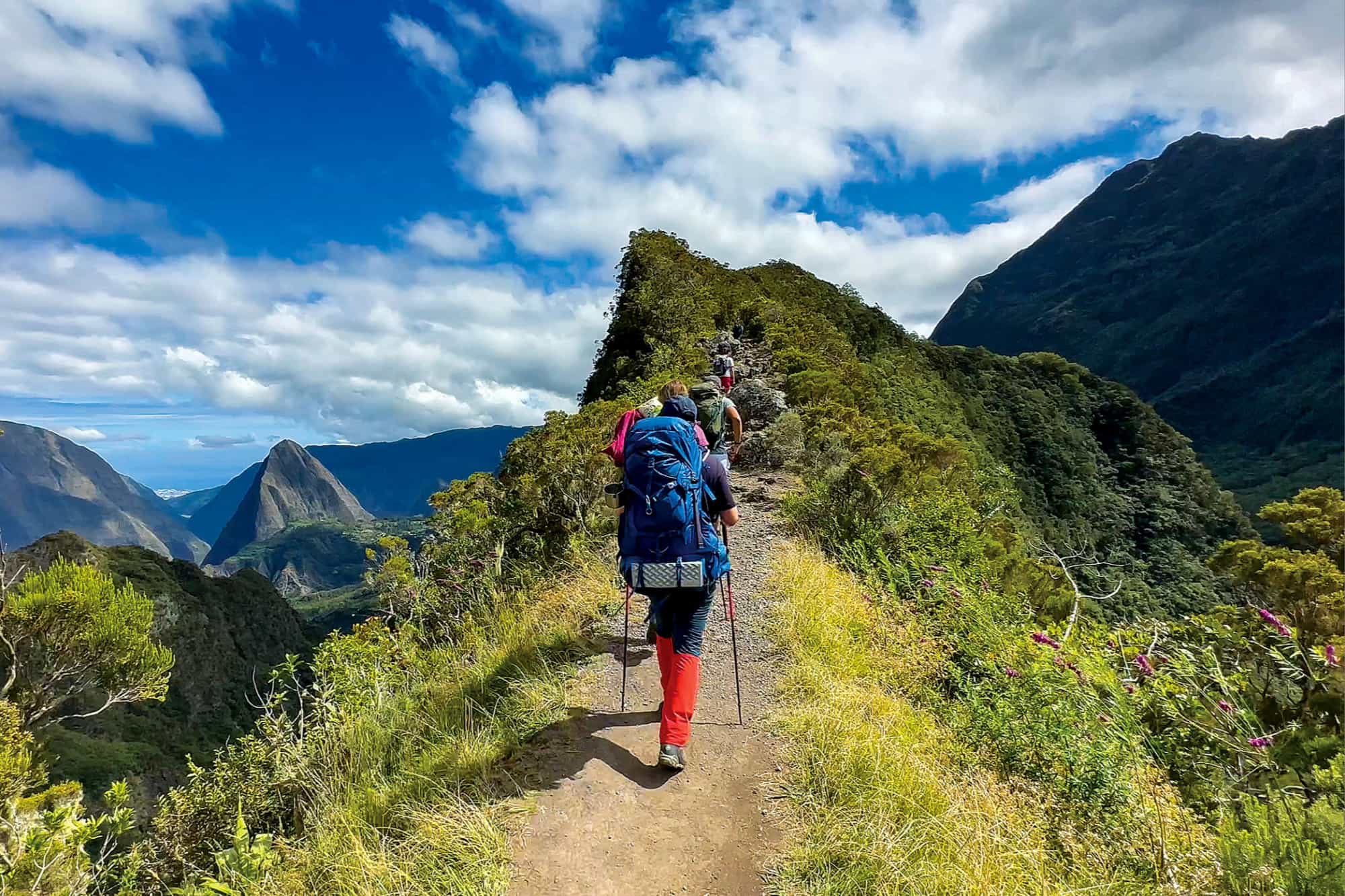
Trek the Grand Traverse of Reunion Island
An unparalleled crossing of a wild and lush mountainous paradise in the middle of the Indian Ocean
What's Included?
Activities & Certified Guides
All itinerary activities with expert, local, English-speaking guidesAccommodation
5 nights in locally owned hotels, 6 nights in gîtes & mountain refugesMeals
All breakfasts, 9 lunches, 9 dinnersTransfers
To and from the airport and everything in betweenLuggage transfer
Luggage drop-off halfway through the traverseSmall Like-minded Groups
Solo-friendly by design, join our small n’ sociable groups of up to 12 like-minded, active and outdoorsy people…
…
What's it like?

























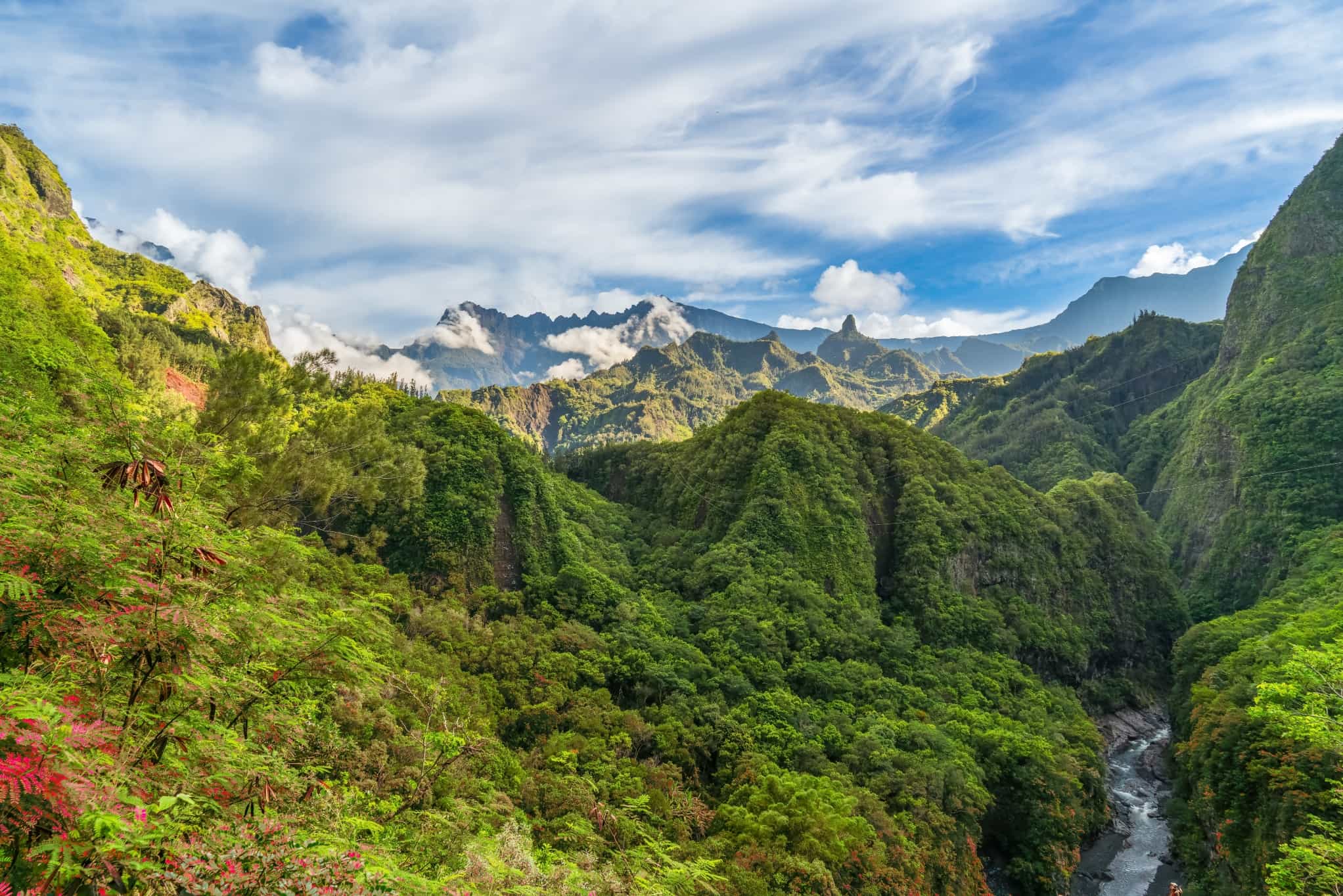
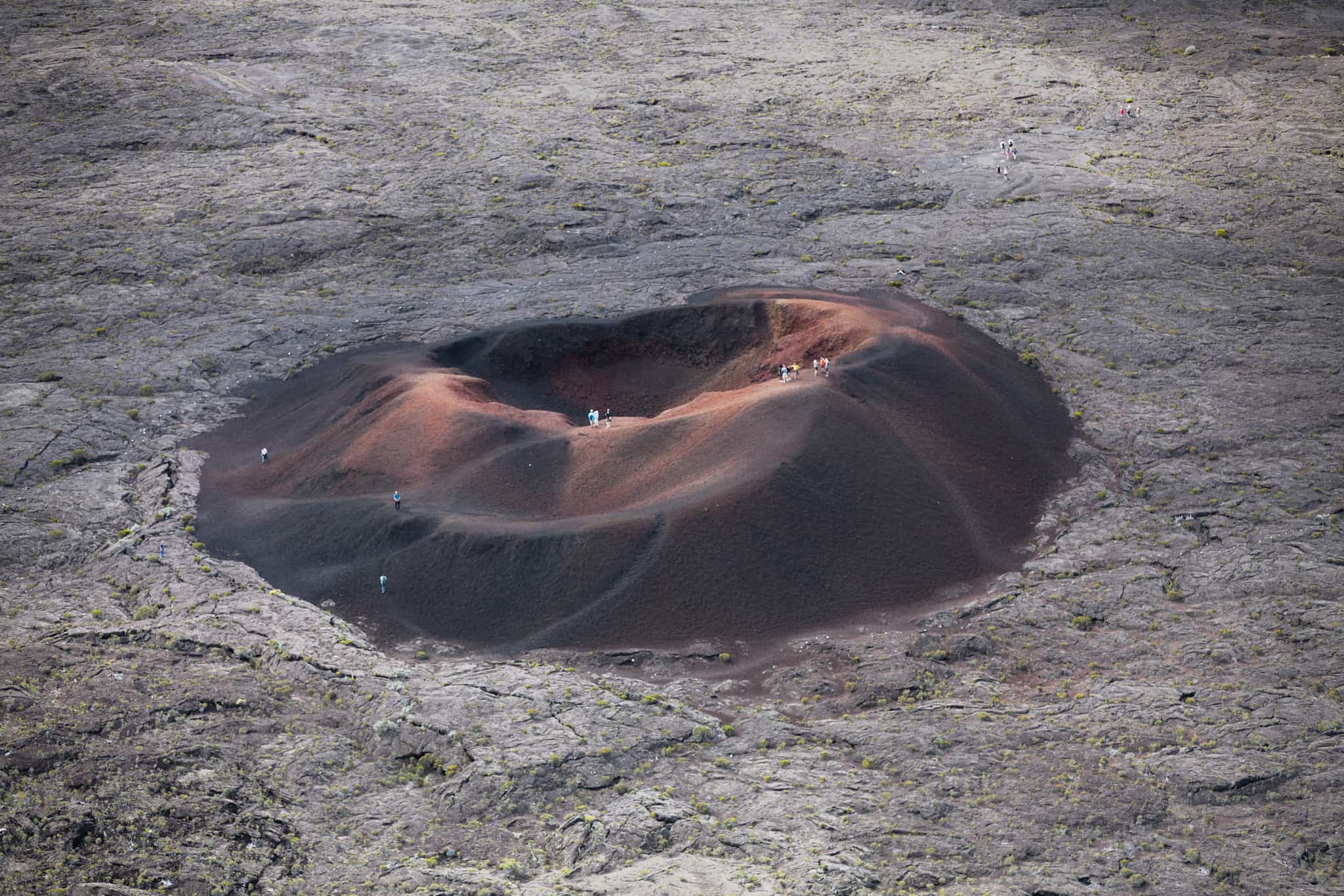
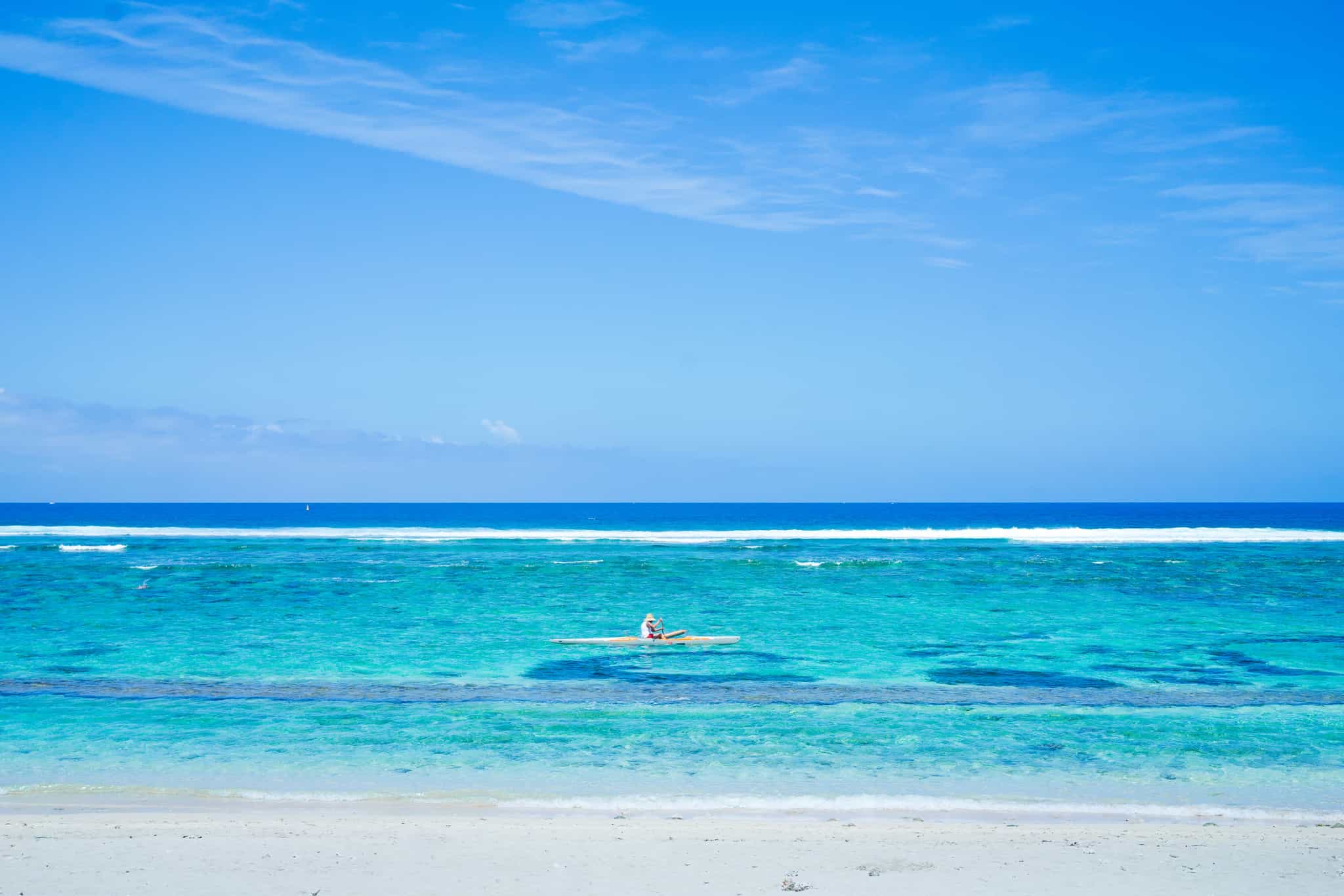
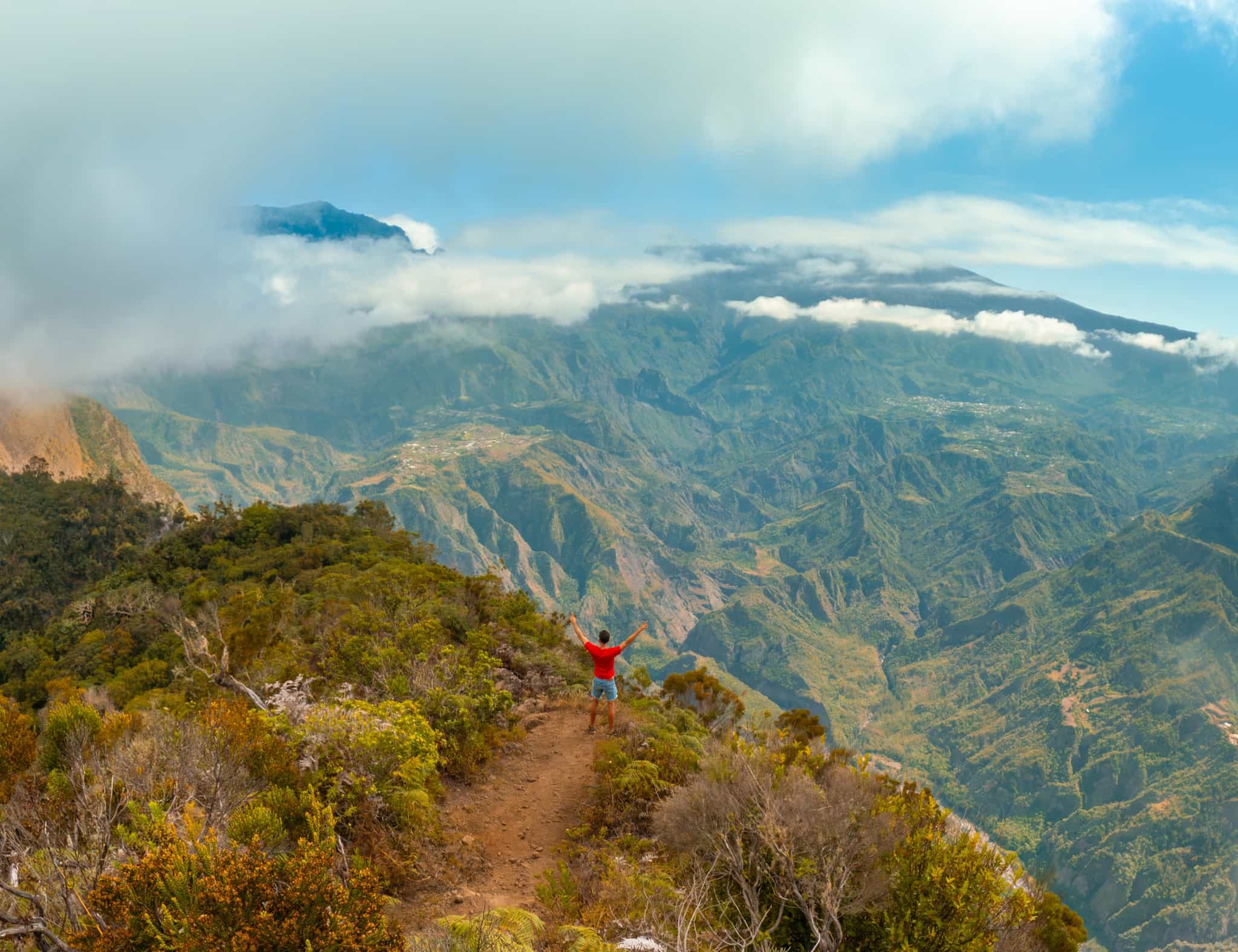
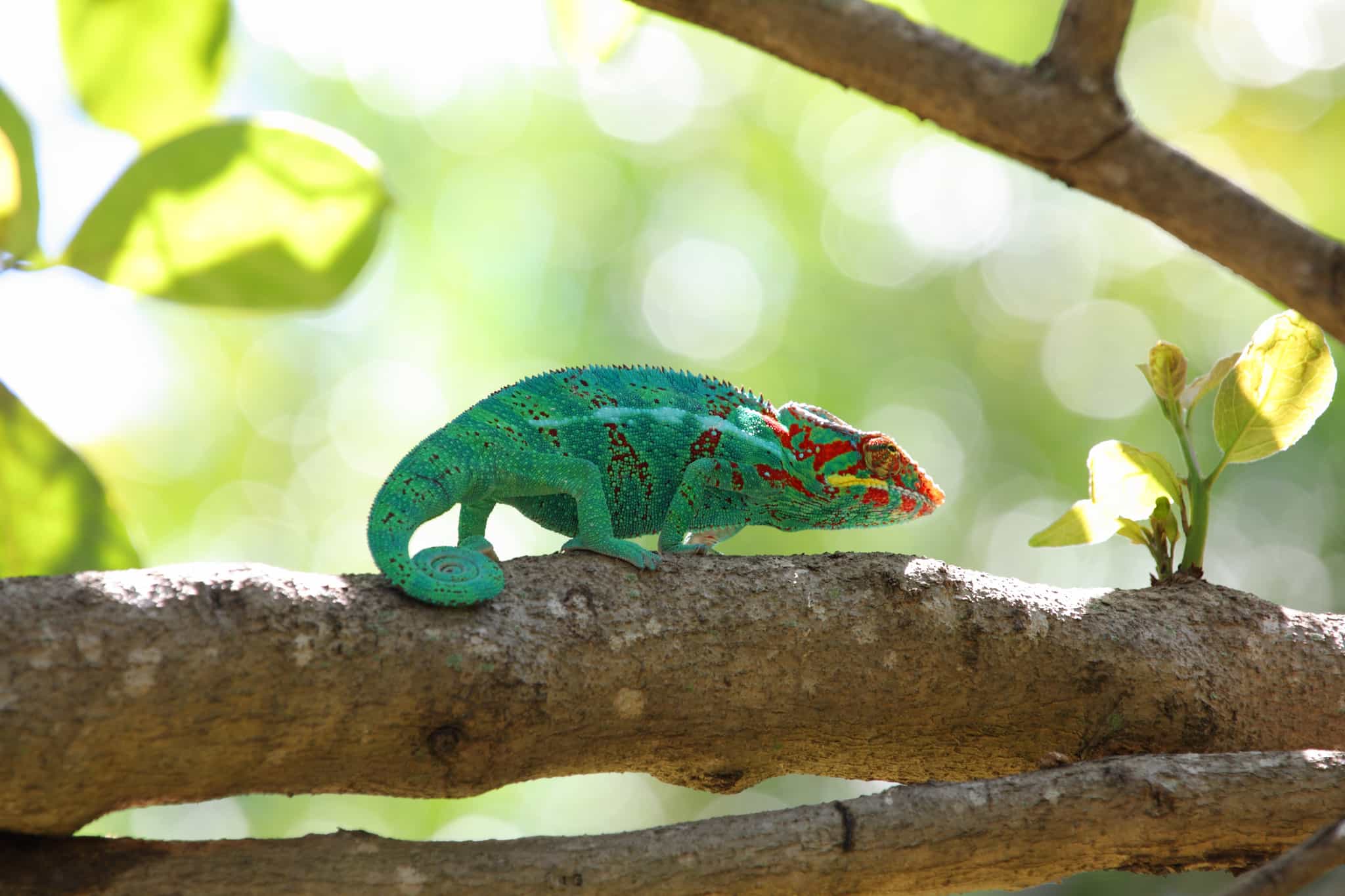
Tales from the trails
Real people, real adventures.
Cross the stunning interior of Reunion Island, a tropical French territory, on foot – with nine days of trekking unlike anywhere else in the world
Enjoy magical sunrise summits atop Piton de la Fournaise, one of the most active volcanoes in the world, and Piton des Neiges, the highest point in the Indian Ocean
Immerse yourself in the natural wonderlands of Reunion's famous cirques, Mafate and Cilaos, and bunk down in a series of remote gîtes nestled in sublime scenery
Wrap up your trek on a beautiful lagoon beach on Reunion's west coast, where you can kick back by the azure, wildlife-rich Indian Ocean
Key Information
Day 1
Rendezvous in Reunion
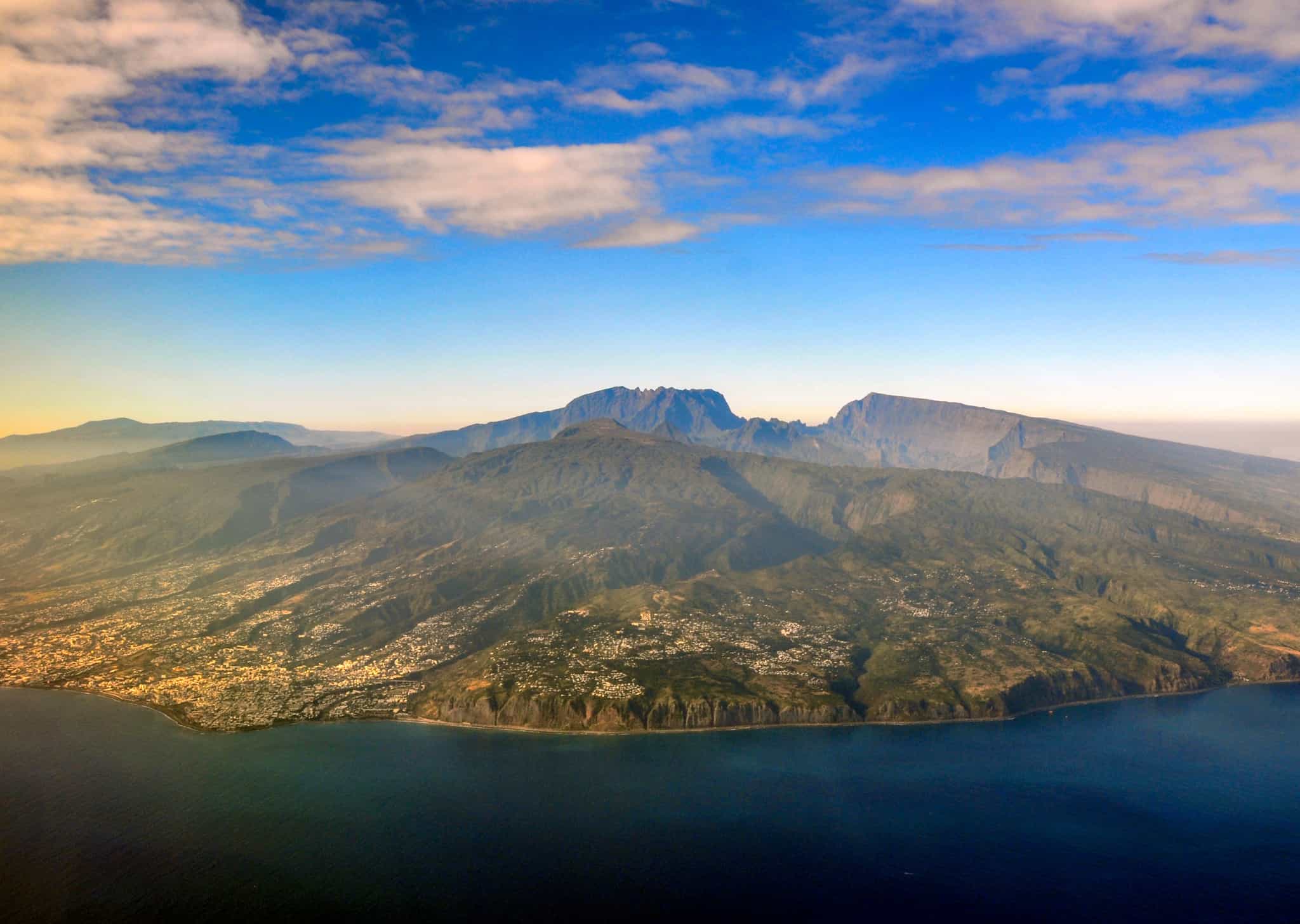
Get your first glimpse of Reunion Island, nestled in the Indian Ocean, as you descend into Saint-Denis Roland Garros Airport. Your host will meet you on arrival and transfer you a short distance to your hotel in downtown Saint-Denis. The rest of today is free to relax after your journey to Reunion; there's a pool at the hotel if you want to chill, or the seafront and historic centre of Saint-Denis are all easily explored on foot. There'll be a meet-up this evening with your guides and fellow adventurers for a welcome dinner and a briefing on the adventure ahead.
Day 2
The trek begins
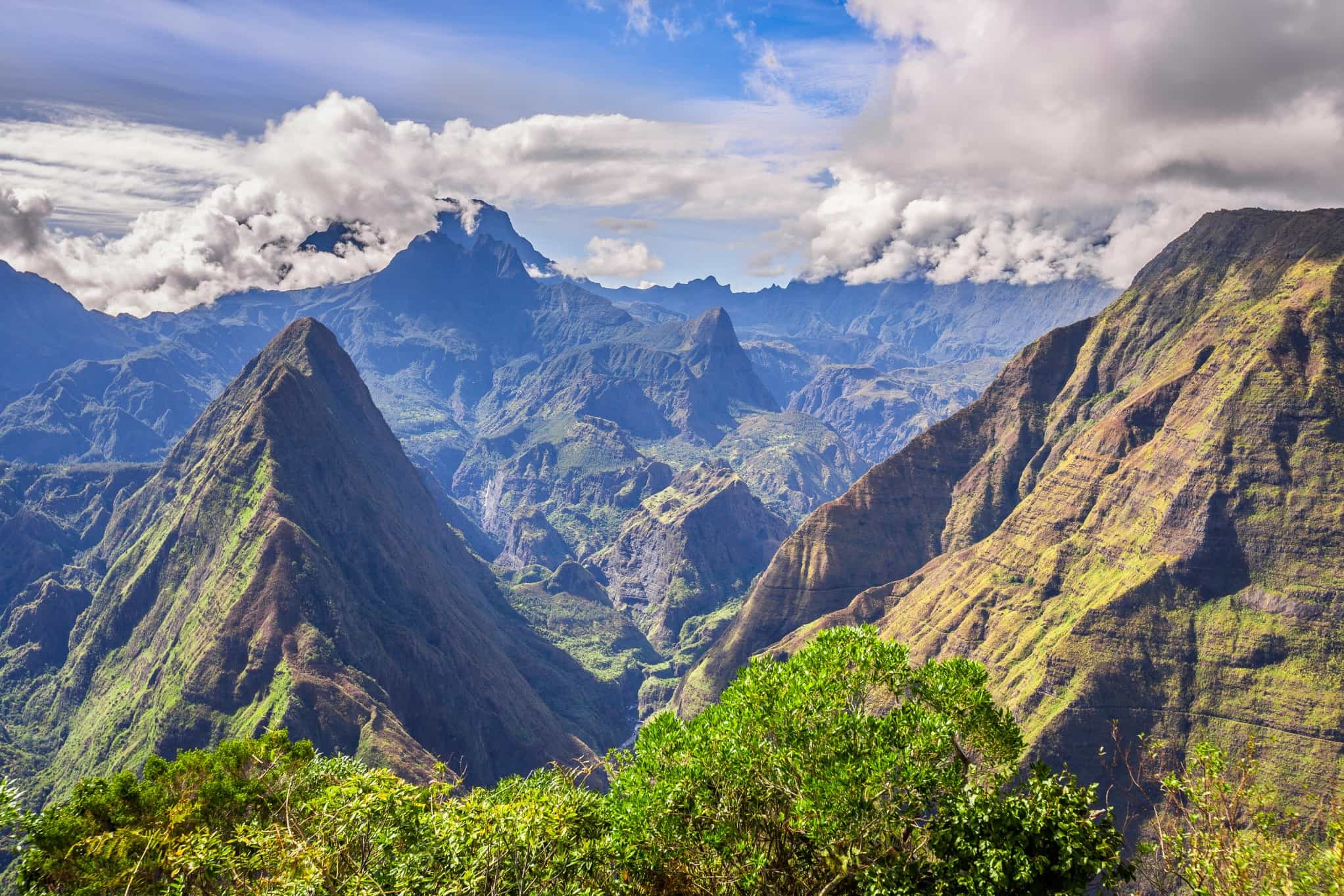
Trekking
Hop in the van for a 45-minute drive to Dos d'Âne, a small village between the sea and the mountains which marks the start point for your grand traverse of the island. The trail sets you off into Reunion's famous cirques – a trilogy of mountainous valleys and natural amphitheatres formed by multiple millennias worth of volcanic activity and erosion. After a short distance you'll begin your descent into the truly stunning Cirque of Mafate via a technical but well-secured trail, ensuring some incredible vistas right from the beginning of your trek. You'll be following the GRR2 trail, a meandering route which allows trekkers to traverse the cirque in four days; Mafate is only accessible by foot which gives the grand traverse a feeling of having gone back in time, with no roads or cars to be seen for several days. Your first stop is at the îlet of Aurère, a small plateau isolated within the rugged terrain. The îlets on Reunion were once the refuge of fugitive slaves, historically known as Maroons. On today's last section between Deux-Bras and Aurère, you'll follow the bed of the Rivière des Galets, crossing the river at several points and eventually reaching Piton Cabris Inn, the first of a series of gîtes that you'll be staying in, tucked away in the rugged interior of Reunion's cirques. Settle in for dinner and a well-earned night's sleep with your first day of trekking under your belt.
Day 3
Through the heart of the Cirque du Mafate
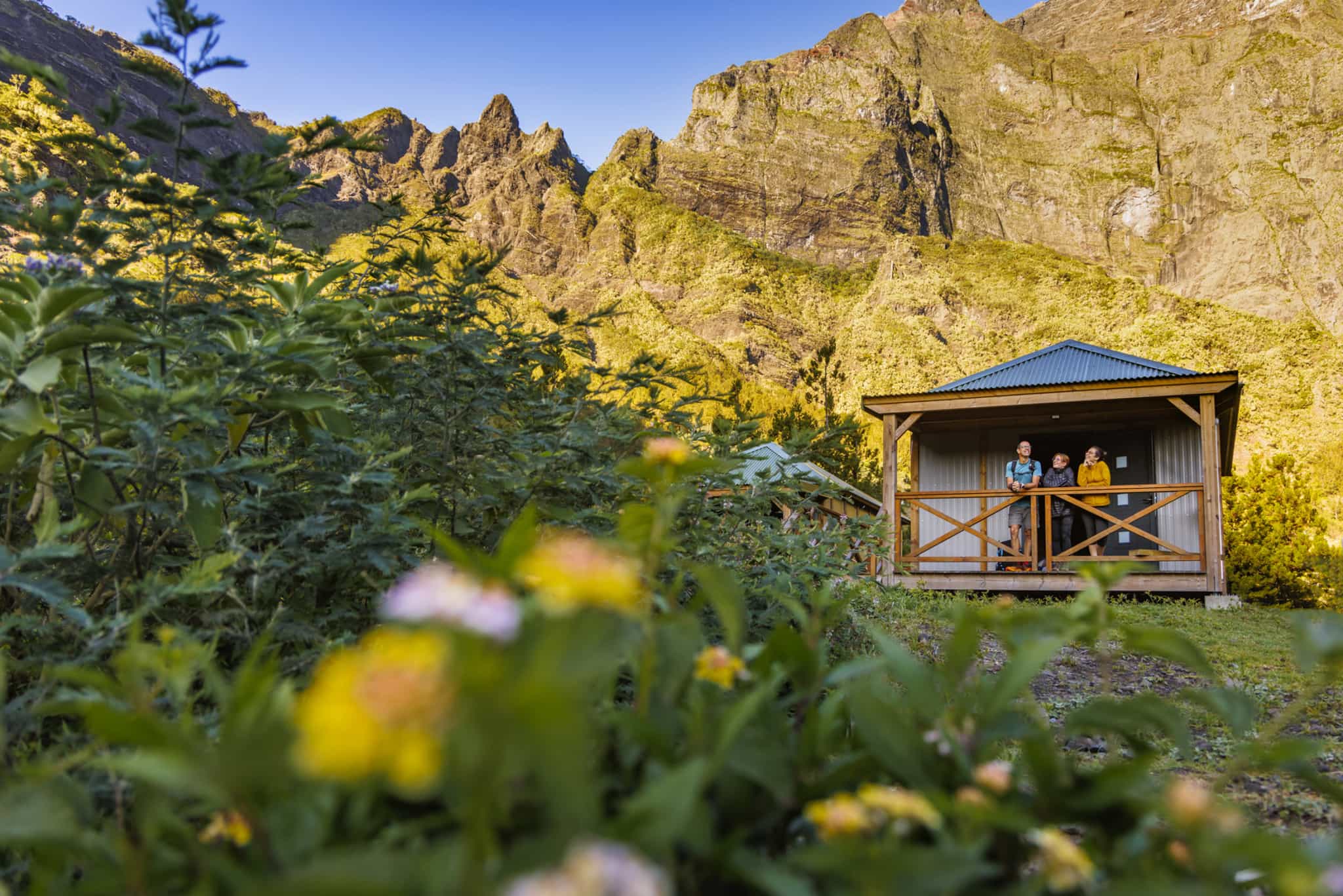
Trekking
Fuel up on breakfast and coffee at the gîte before setting off for the next stage through the Cirque of Mafate, continuing along the GRR2. Along this section you'll have ample time to take in the breathtaking scenery of the heart of Mafate as you pass through the charming hamlets of îlet à Malheur, îlet à Bourse, and Grand-Place-les-Hauts. The grocery shop at Le Pavillon Lodge is a great place to stock up on snacks and supplies, before descending to the bridge over the Rivière des Galets which will take you to the western side of the cirque. A steep climb with many steps awaits you here, leading all the way to îlet des Orangers, where you’ll stay for the night nestled in an incredible and remote spot that's worth the tough ascent to get there.
Day 4
îlet des Orangers to Marla
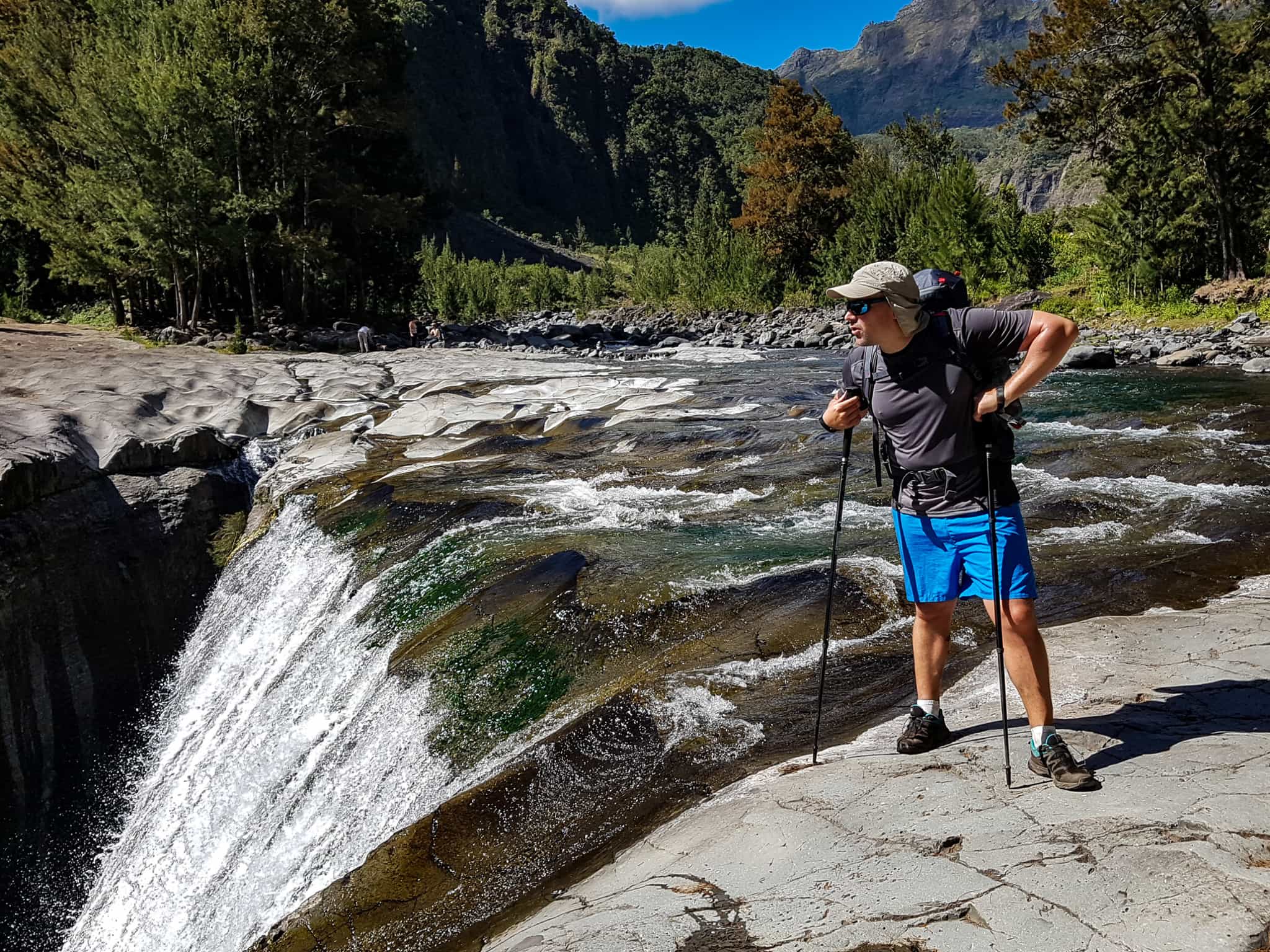
Trekking
Wake up in a truly memorable location, waiting for the sun to rise above the peaks and light up the valley around you before breakfast and coffee to fuel you up for the day. A final full stage through Mafate awaits as you lace up your boots and set off on the GRR2 from îlet des Orangers, with a scenic meandering ascent through a rocky ravine taking you to Roche-Plate. Here, you'll switch trails to avoid a section of technical passages with steep descents and vertiginous, exposed points. You'll take an alternative route to Marla via the geological site of Trois-Roches with its impressive waterfall, an ideal spot for a nice picnic. Finish up today's route at another picturesque gîte at the foot of the Col du Taïbit – a ridgeline that separates the cirques of Mafate and Cilaos.
Day 5
Marla to Cilaos, via the Col du Taïbit

Trekking
Today kicks off in adventurous fashion with an ascent of a mythical pass: the Col du Taïbit, perched at an altitude of 2081m. You'll gradually climb the ridgeline, bidding farewell to the Cirque du Mafate which has been your home for the past few days as the route transitions into the Cirque du Cilaos. The Col du Taïbit is a prominent section of a famous trail-running race known as 'The Diagonal of Fools' – you'll be taking it a little easier than the trail runners along the ridge today, with your pack in tow. Back on the GRR2 trail, take in the epic expanse of views over the Cirque du Cilaos as you descend towards the town of the same name, this long route dotted with beautiful rivers, waterfalls and canyons. After several days away from civilisation, Cilaos will welcome you with its friendly mountain town vibe as you settle into a hotel for the next two nights, slowing down the pace of the trek a little ahead of the big effort required on the second half of the Grand Traverse of Reunion in the days to come.
Day 6
Hike, canyon or rest up in Cilaos
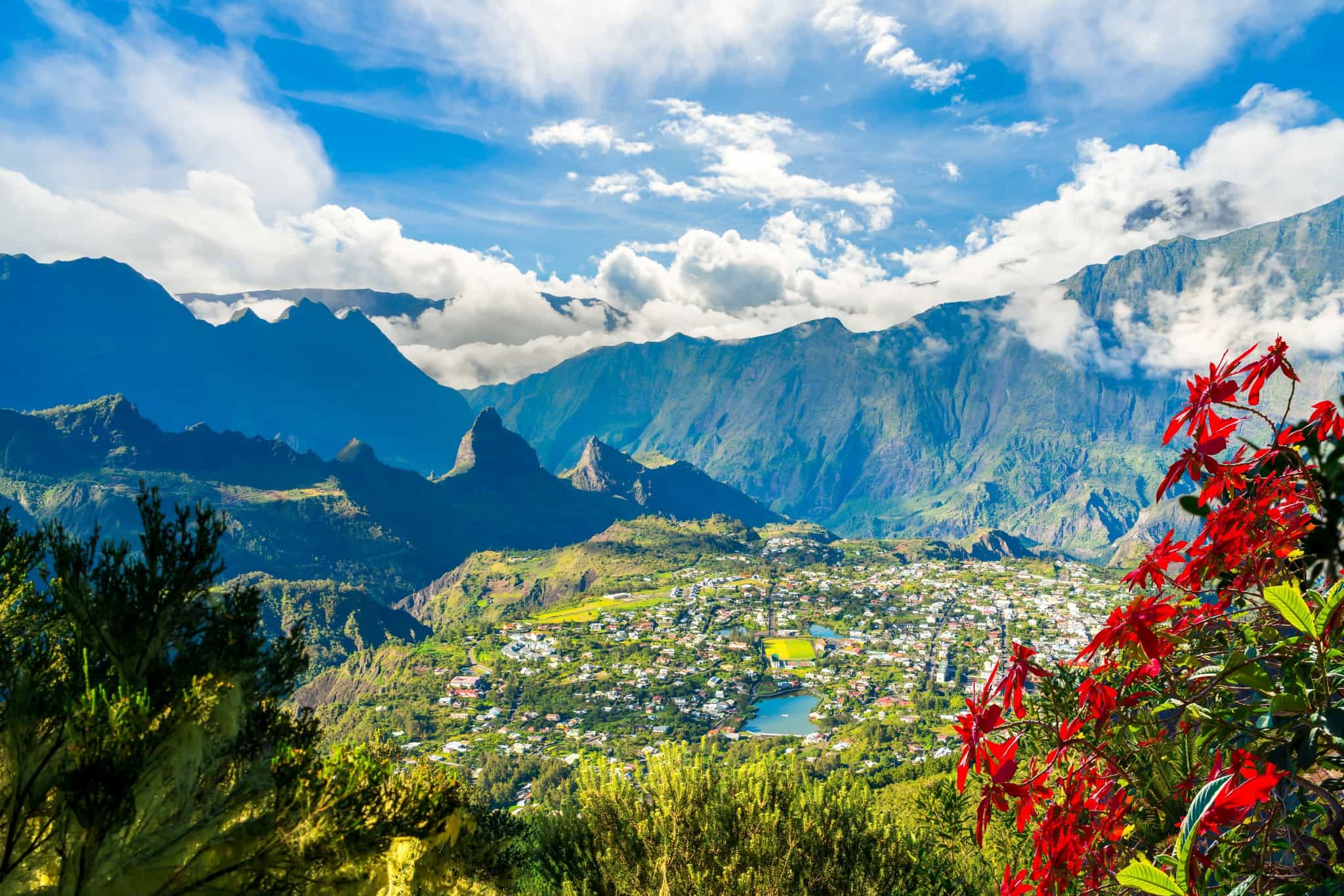
Hiking
Today is all about soaking up Cilaos and exploring one of three ways: the relaxed way, the adventurous way, or the super-adventurous way. If you want to take a load off your feet and relax in the town today, chilling at your hotel and spa surrounded by the highest mountains on the island, then that's all good and a fine choice! For those keen for more hiking today, your guide will lead a day hike along a beautiful trail called 'Le sentier de la Chapelle' to discover the cirque. This trail takes in a good chunk of the cirque outside of Cilaos with 4-5 hours of hiking, including exploring one of Cilaos' famous canyons to reach an incredible stone cathedral. The other optional activity today is to go canyoning – Cilaos is a fantastic place to do this experience, so if you're a fan of getting wet and wild and tackling natural water slides, rappels and jumps into natural pools and wish to tick this off during your time in the Indian Ocean, then this is the place to do it. Please note that this guided activity is not included in the trip cost - it is operated by a local company (not by our host partner) and is payable locally.
Day 7
Cilaos to Piton des Neiges refuge
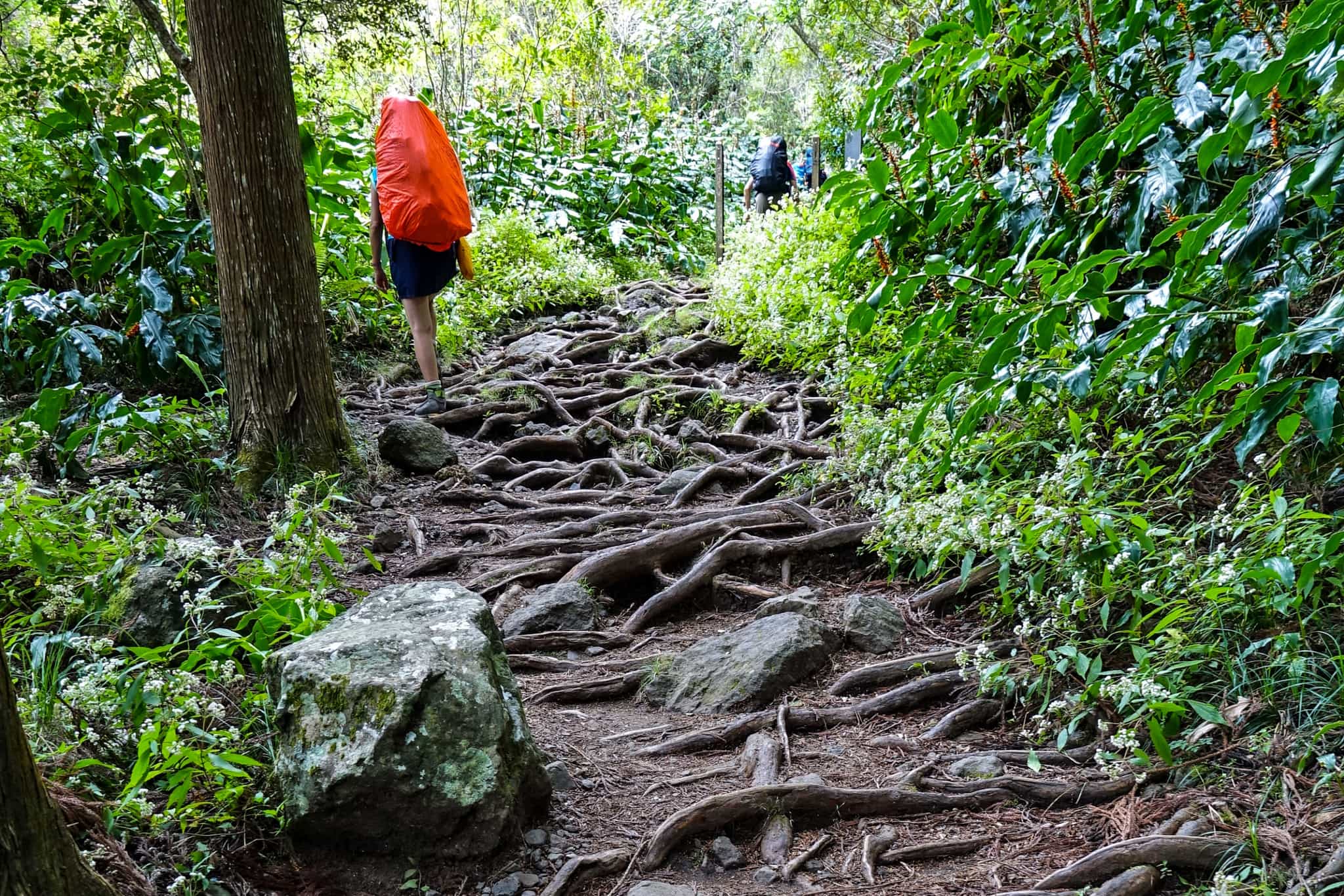
Trekking
Leave Cilaos behind to get back on with the job at hand – kicking off the second half of your great crossing of Reunion. Today is almost all uphill, with a lung-busting but beautiful climb to reach the Caverne Dufour hut, nestled below the Piton des Neiges – the highest point in the Indian Ocean. Bunk down in the mountain refuge here, surrounded by lunar-like terrain, near the summit of this 3069m-high volcano which emerged from the sea over two million years ago. Depending on the weather and group energy levels, you might head up to Piton des Neiges for sunset, a pretty unforgettable spot to watch the day fade. Otherwise alarms will be set for a very early rise in the morning...
Day 8
Sunrise at Piton des Neiges (3069m) and on to Bélouve
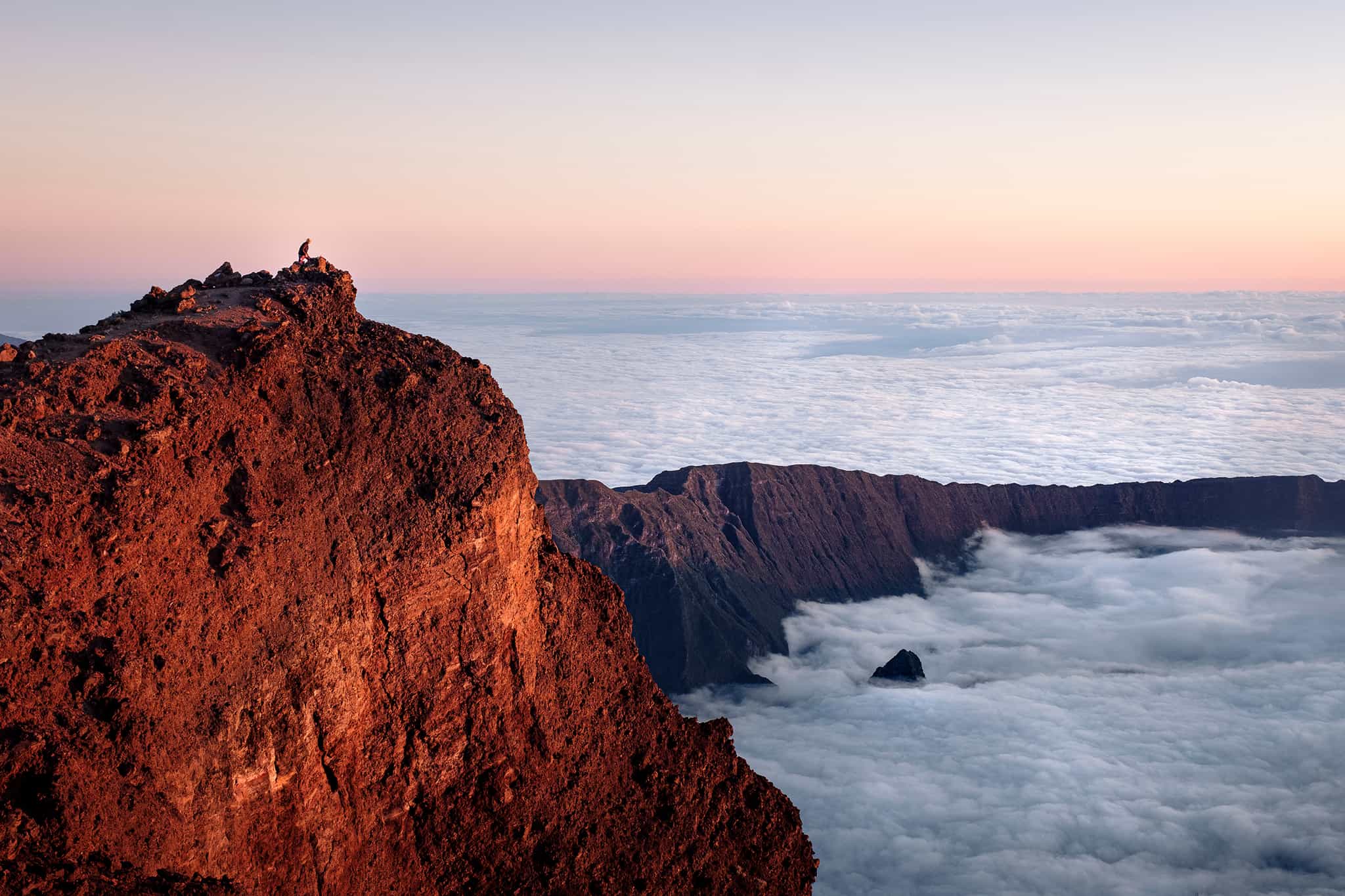
Trekking
If you didn't make the sunset yesterday, you will rise early – very early – and roll out of the refuge while the stars are still out. You'll wrap up with warm layers and a headtorch and set off at around 04:00 to climb Piton des Neiges straight from the refuge. The first light of the day will help guide the way towards the summit, allowing you to reach it in time for a magical sunrise from the highest point of the Indian Ocean at 3069m. Take in this memorable moment, looking out across the island of Reunion (or at a blanket of cloud below you, depending on the conditions) before descending. The round trip to the summit and back takes approximately three hours, with 600m of up and down to get through. This is all before the next stage of the traverse itself, which you'll tackle after breakfast, so today is a really big day. It is optional to sit out the summit section if you wish. After breakfast, you’ll descend along the GRR1 trail towards the edge of the Bélouve forest. The path can be muddy underfoot, weaving along cliff edges with cracking views across the Cirque de Salazie - Réunion’s third cirque - where thick forest and tumbling waterfalls spill down the valley. By mid-afternoon, you’ll reach the Bélouve lodge where you'll spend the night.
Day 9
Bélouve Forest and Trou De Fer Waterfalls
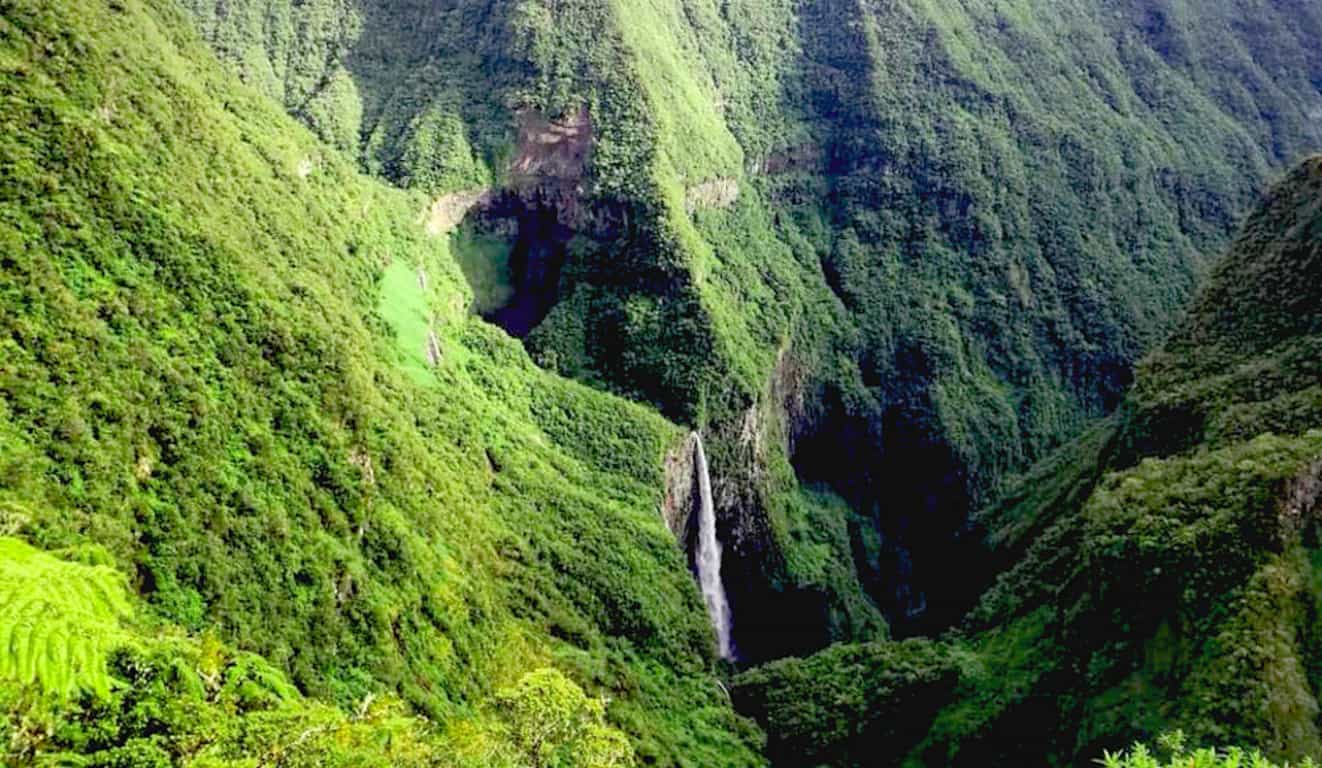
Trekking
After breakfast, you’ll head into the heart of the Bélouve forest reserve, where towering ferns and thick greenery give the place a primeval feel. The trail winds through this ancient woodland to a dramatic viewpoint above the Trou de Fer gorge, where waterfalls plunge over 300 metres into the depths below. Around midday, you’ll return to the lodge for a picnic before hopping in a private transfer bound for the Piton de la Fournaise massif. The scenery shifts fast - from dense forest to the rolling pastures of the Plaine des Cafres, then on to the stark volcanic terrain of the Fournaise region. You’ll stop off at a few cracking viewpoints en route before being dropped at Bois Ozoux, where the GRR2 trail leads gently uphill to the Sainte-Thérèse oratory. From here, soak up sweeping views across the Plaine des Sables, a vast, lunar-like plateau of black volcanic rock set over 2,300 metres above sea level. You’ll cross the plateau on foot to reach the Pas de Bellecombe, where the volcano lodge awaits for a night in this otherworldly landscape.
Day 10
The final stretch
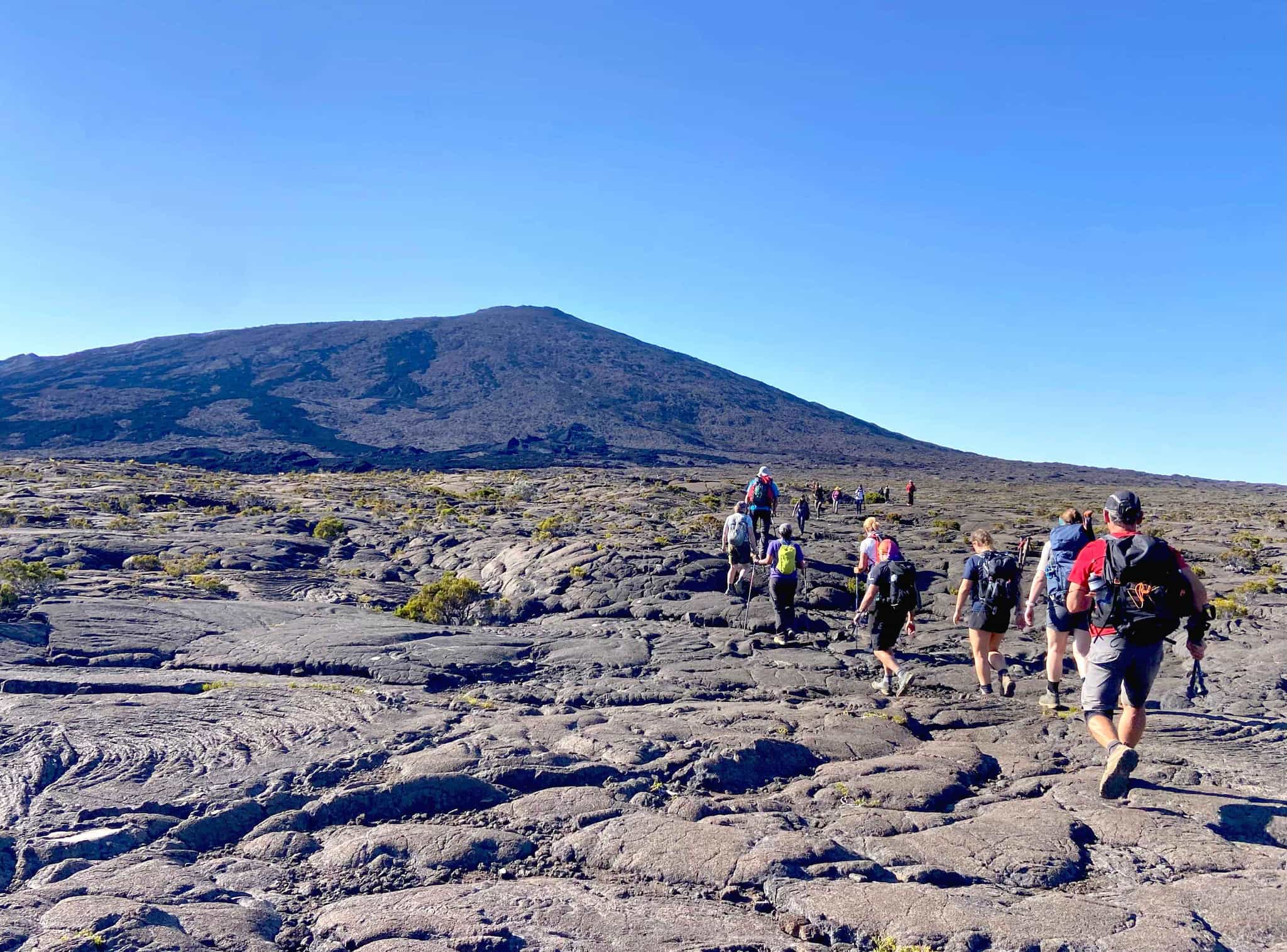
Trekking
Another volcano sunrise hike kicks off this morning; however, it's a much easier and quicker undertaking compared with the one a few days ago. A 20-minute hike down to the Piton de la Fournaise at around 06:00 allows you to soak up the incredible light and colours as the darkness changes to the first light of the day. Hike back up to the gîte for breakfast, then the final section of your epic traverse gets underway. Trek down further into the volcanic area below, passing near a crater called 'Formica Léo' with its tones of ochre and vivid red, then continue your route to the summit of the main crater of the volcano, the Dolomieu crater. The trek officially ends today, with the final six hours or so of trekking under your belt. You've walked across the bulk of the island, covering 120km and eating into 9000m of elevation gain and 7500m of descent: a truly epic effort! A driver will meet you at the end point to transfer you to Reunion's glistening west coast area and your accommodation close to the beautiful lagoon beaches at L’Hermitage-les-Bains. Grab a sundowner to toast your achievement while watching the sunset over the Indian Ocean.
Day 11
Chill by the Indian Ocean
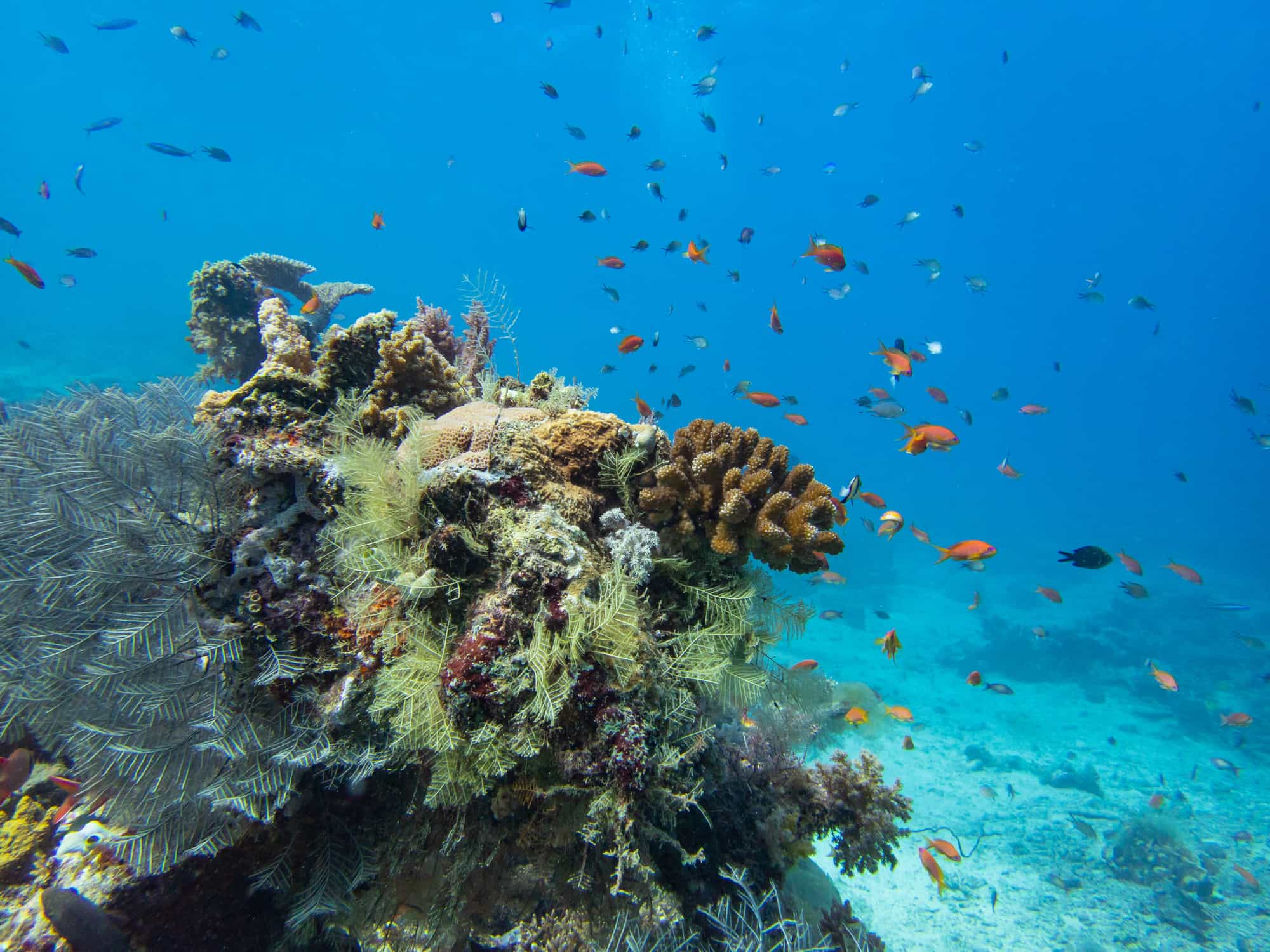
You've earned the right to do anything you please today. No trip to this part of the world is complete without some time soaking up the incredible coastline and tropical ocean. Your base is ideal for either relaxing at the beautiful lagoon beach at L’Hermitage-les-Bains, swimming and snorkelling whenever you wish, or if you're keen to pack more adventure in, there are a number of activities that your host can help organise for you. Whale- and dolphin-watching trips are popular from July to October when the humpbacks are around, scuba diving trips are a possibility nearby (for those qualified) to dive above Reunion's coral reefs, or you can take a scenic helicopter flight over the island for a different perspective of the incredible landscape you spent the past 10 days trekking through.
Day 12
The adventure comes to an end
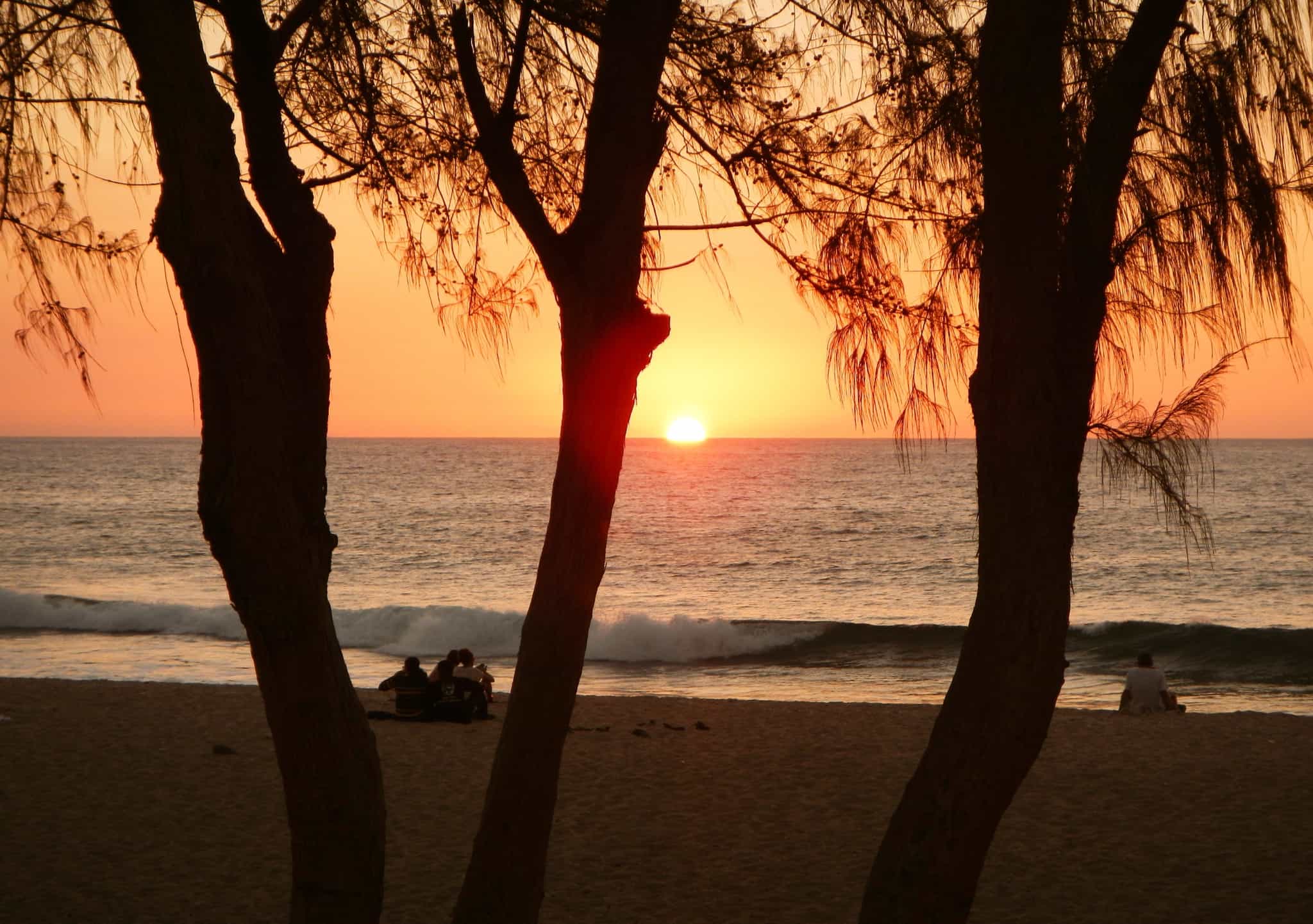
The time has come to bid a fond farewell to your host as they take you back to Saint-Denis for your onward flight back to the real world.
The Area
Logistics
Starts
Roland Garros Airport (RUN), Saint-Denis, Reunion
Any time on Day 1
Ends
Roland Garros Airport (RUN), Saint-Denis, Reunion
Anytime on Day 12
Transfers
Your host will meet you on arrival at Roland Garros Airport, Reunion's main gateway located just outside its capital, Saint-Denis. You'll be transferred a short distance into town to your accommodation ahead of meeting up with the rest of the group. On the last day of the trip, your host will drop you back off at the same airport in time for any onward flights. Transfers between Roland Garros Airport and your hotels at the start and end of the trip are provided for any flight arriving on Day 1, and departing on Day 12 of the trip. If you wish to arrive earlier or stay on later, your host can arrange private transfers for an additional cost. See Optional Extras for details.
Travel options
There are direct flights to Reunion's Roland Garros Airport from Paris, Johannesburg, Bangkok, Mauritius and the Seychelles. Travellers from myriad origin points across Europe and North America can reach Reunion via one of those five transit points to connect to the direct flights.
Day 1
Breakfast
Lunch
Dinner
Day 2 – Day 4
Breakfast
Lunch
Dinner
Day 5 – Day 6
Breakfast
Lunch
Dinner
Day 7
Breakfast
Lunch
Dinner
Day 8
Breakfast
Lunch
Dinner
Day 9
Breakfast
Lunch
Dinner
Day 10
Breakfast
Lunch
Dinner
Day 11
Breakfast
Lunch
Dinner
Day 12
Breakfast
Lunch
Dinner
What is the food like?

Breakfasts at the hotels are buffet style, involving pastries, fruits, eggs, bread, cheeses and meats plus juices, teas and coffees. At the gîtes and mountain refuges along the route, the food is more basic and the choice can be limited. Breakfasts can sometimes be only bread and jam, and Dinner is generally rice, lentils and vegetables with a meat option, such as goat and chicken. If you like to end a long day of trekking with a well-earned beverage, rum is plentiful on the island, as is the local bottled beer known affectionately as 'Dodo'. Each day along the trek you'll have a picnic lunch, which you'll collect from the gîte each morning before setting off.
A handful of lunches and dinners on this trip are not included (at Cilaos, and on the coast at the end) to allow you to pop into local cafes and restaurants to sample the Creole cuisine on the island. Some popular food and dishes to try whilst in Reunion are cari (Reunion's national dish, a type of curry made with meat, fish, or vegetables); palm heart salad (aka 'millionaire salad', made from the tender shoot of the coconut palm); rougaille sausage (a delicious sausage stew); the popular sweet potatoes cakes; chouchou (a native pumpkin variety); tomato rougail (typical Creole sauce) and chayote (vegetable often braised and served in a gratin).
Vegetarians, vegans and other dietary requirements and allergies can be catered for – please just request this on your passenger info form.
What is the accommodation like?
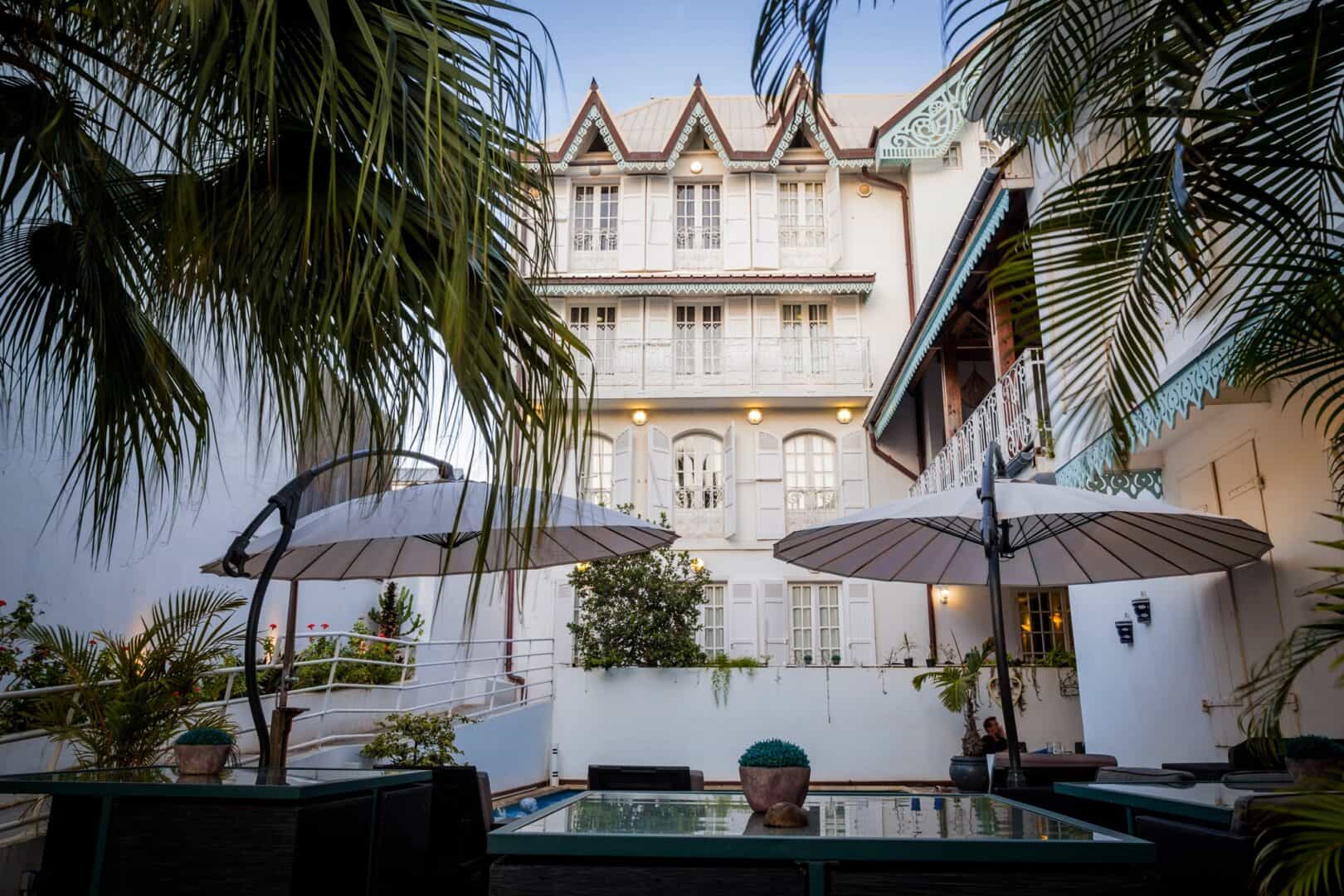
Saint-Denis
On your first night in Reunion you'll stay at the Hotel Le Juliette Dodu. This small, palace-style property is located in a historic East India Company building in the heart of Saint-Denis, and oozes homely Creole charm. You'll stay in ensuite rooms on a twin-share basis, all of which have air-con, free WiFi, a TV and a safe. The hotel also has a outdoor pool.
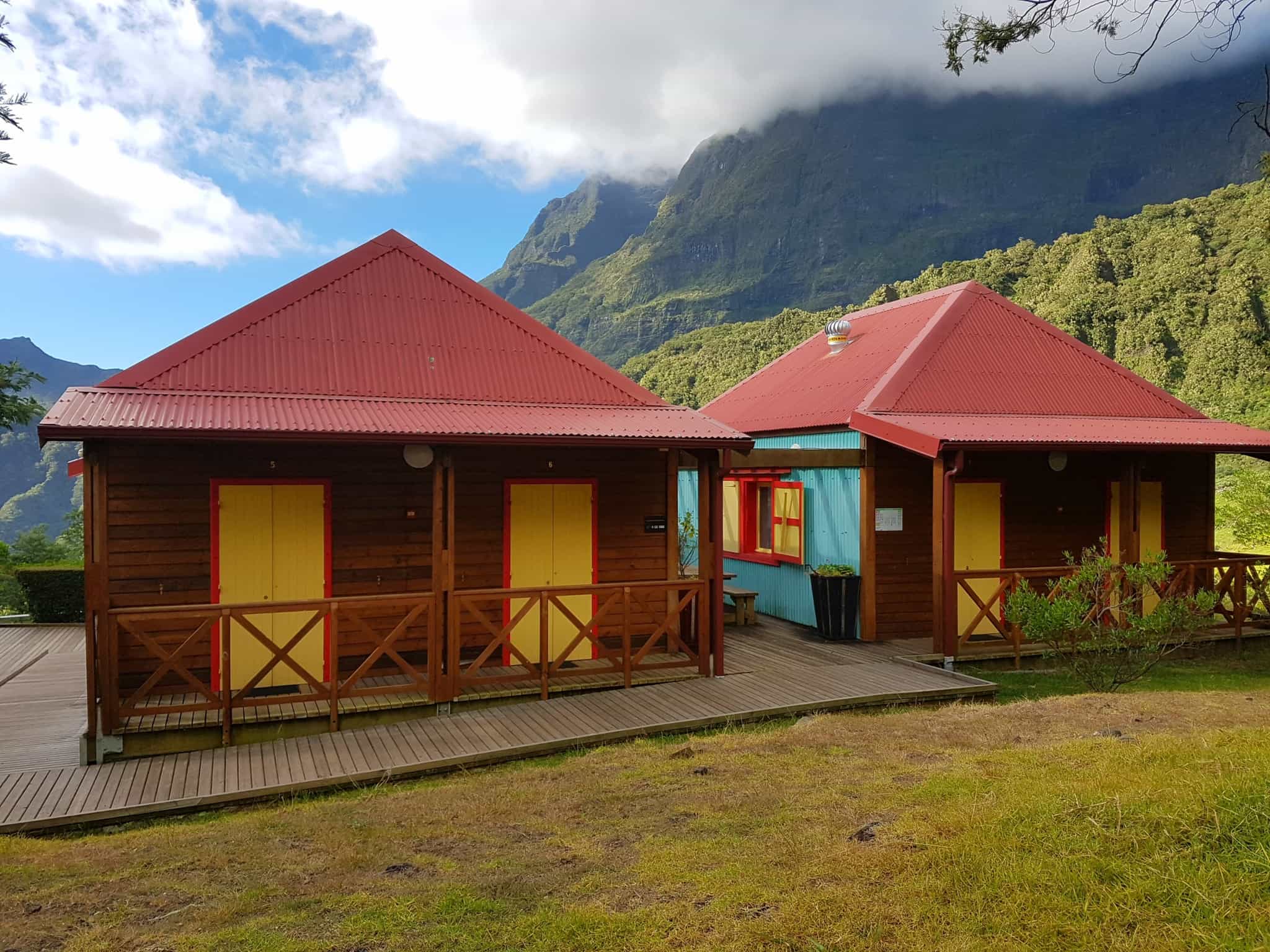
Along the trekking route
Throughout the traverse, you'll bunk down along the route at a series of gîtes and mountain refuges situated in stunning surroundings. Both the gîtes and the mountain refuges are simple, but cosy and characterful. Bathroom facilities are shared – and there is hot water at each place. Clean bedding is provided by the refuges, but you'll need to bring your own travel towel as towels are not supplied. There are electrical points in the communal dining areas to charge your phone, camera etc. Refuge du Piton des Neiges is the most remote and the most basic; while staying here the charging of personal items is not permitted due to the limited solar power available. While blankets are provided at Refuge du Piton des Neiges, you will need to bring a travel bed sheet to fit a single bed for your night's stay here. Below are the gîtes and mountain refuges you'll stay in, and which size rooms to expect at each.
Auberge du Piton Cabris: 4-bed dorms
Gîte du Cirque: 4-bed dorms
Chez Fanélie César mountain lodge: 4-bed dorms
Refuge du Piton des Neiges: 9-bed and 15-bed dorms
Hydrangea Mountain Lodge & guesthouse: 4-bed dorms and twin rooms
Gîte du Volcan: 4-bed and 6-bed dorms
Please note that the dorm rooms will often be mixed-gender.
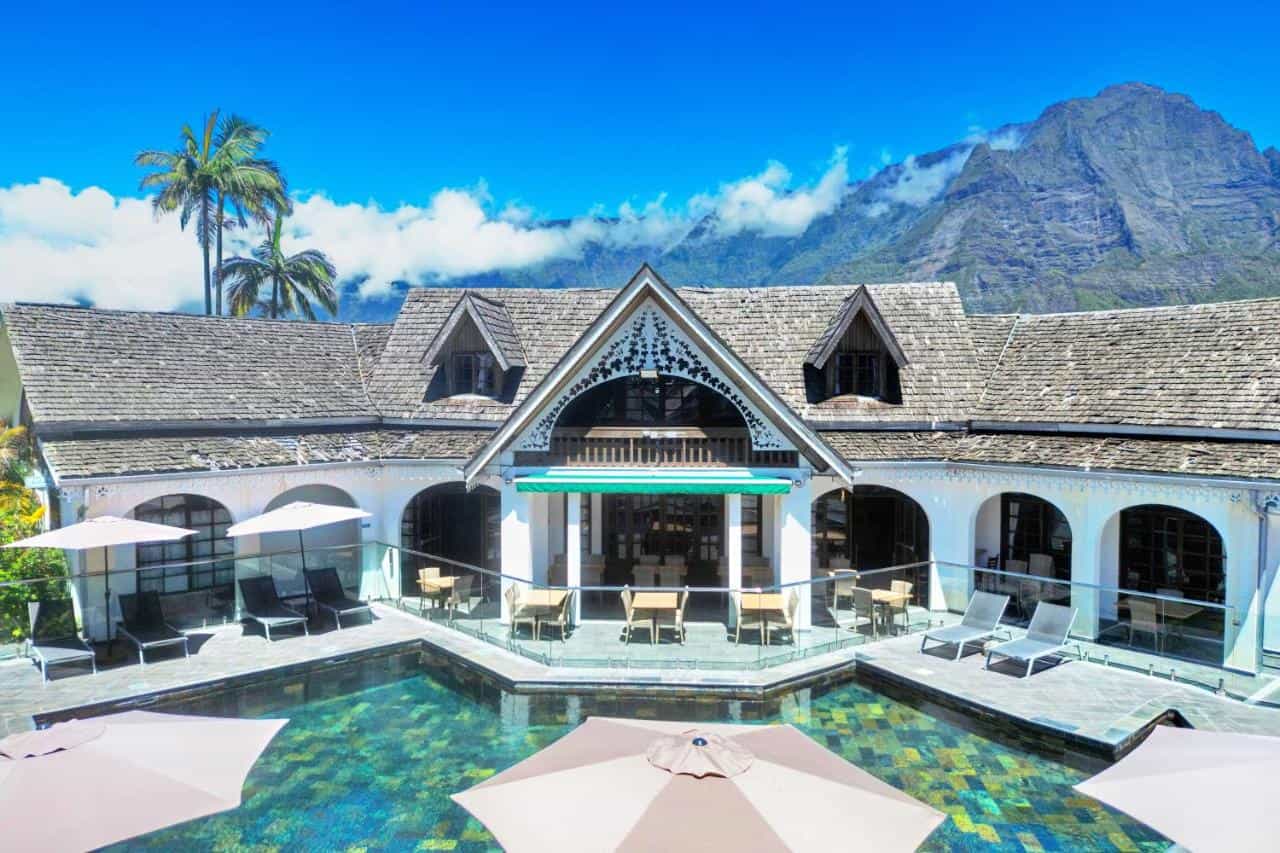
Cilaos
After spending four days and three nights of trekking through the Cirque du Mafate, only accessible by foot with no roads or infrastructure, you'll reach Cilaos in the afternoon of Day 5 ready for some creature comforts. The grand traverse pauses at this stage to allow you to soak up this beautiful spa town for two nights. Your base here is Le Vieux Cep, a 3-star hotel and spa – newly renovated and blessed with arcing views of the surrounding mountains. You'll stay in comfortable twin-share rooms with ensuite bathrooms. Le Vieux Cep has a 'wellness oasis' to help you reboot at this midpoint of the trek, with jacuzzi and hammam facilities to soothe any aching limbs, and even a counter-current pool for a swim in a beautiful setting.
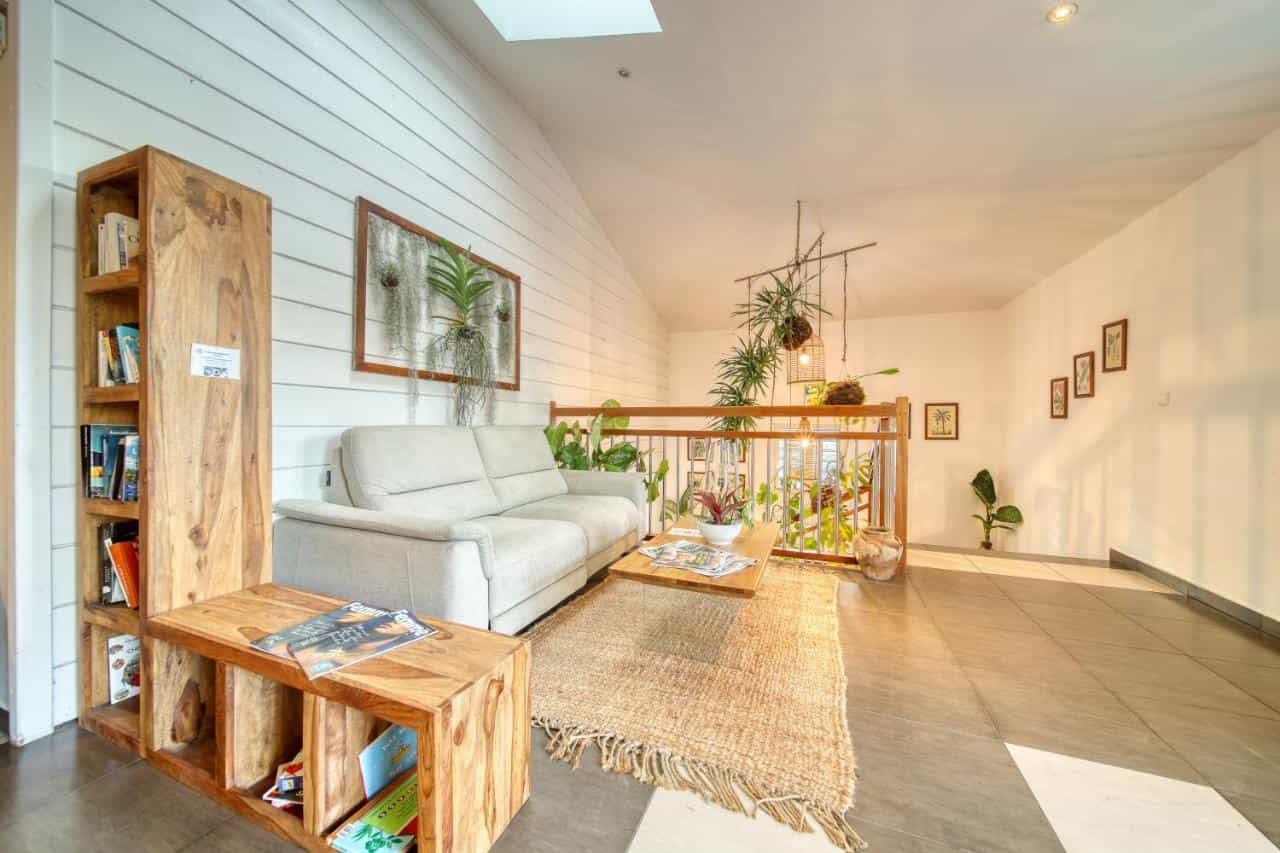
On Reunion's West Coast
Having completed the traverse, your final two nights of the trip are spent at a beautiful spot on the west coast of Reunion. Located 80 metres from the sandy beach in L'Hermitage-les-Bains, the Tropic Appart Hotel is your base to relax or explore more of Reunion on your final day. The hotel has stylish rooms with air-conditioning and lovely decor, plus an outdoor pool and a tropical garden.
Please note that some rooms are in a duplex set-up, with a bedroom and bathroom upstairs, and a separate sleeping area with its own bathroom downstairs, offering both comfort and flexibility for solo travellers, couples, or friends sharing.
Upgrades
For solo travellers wanting their own space, you can request a solo room upgrade for the five nights which are spent in hotels on this trip. Please request on booking, as this is subject to availability. See Optional Extras for prices. There is no option for solo rooms at either the gîtes or the mountain refuges. Please note that a single room at the Tropic Appart hotel may be in a 'duplex' set up, as explained above.
This trip has been rated as Challenging
This trip has been rated Challenging due to consecutive days of up to seven hours trekking with plenty of climbing up and down. You must be capable of hiking all day for several consecutive days on trails of varying difficulty with steep sections on uneven ground. On average, you'll be tackling 900m of elevation gain and 750m of elevation loss each day, with some longer lung-busting days including Day 7 where you'll be summiting Piton des Neiges (3069m) - the highest point of the Indian Ocean.
Given the nature of the trip it is worth having some previous multi-day hiking or trekking experience under your belt as you’ll need to be comfortable with long back to back days - several with over 1000m ascent. The best way to prepare for this trip is to get out walking in the hills at home and try to mimic the daily distance and elevations you will encounter. We’d recommend trying to get in at least a couple of back to back days over weekends in the build up to the trip. This will also provide a chance to test out kit, footwear and all important snack choices! General cardio, strength and flexibility programs will also help build your fitness and preparedness for hiking in the mountains, it’s best to begin preparations at least 8-12 weeks prior to your trip. The fitter and more prepared you are, the more you will enjoy this trip.
What if i need to skip an activity?
The only day on which it is feasible to skip the entire day is Day 6, when the group remain in Cilaos for two nights. There is a planned hike this day, with optional activities such as canyoning. But you do have the option to just take a rest day on this day, should you prefer.
On Day 8, it is possible to sit out the summit section of Piton des Neiges. The round trip to the summit at 3069m takes approximately three hours, with 600m of up and down. The sunrise views at the top are well worth the effort, but equally there is the opportunity to wait for the group at the refuge and miss out this section before continuing on with the group to Bourg-Murat later that day.
What will I need to carry?
You'll need to carry your own trekking backpack throughout the trip. This should be a 35-50 litre trekking pack with waist straps. A lighter pack will be more enjoyable, but also don't skip the essentials and risk getting caught out in bad weather. You'll need to carry waterproofs, change of clothes and underwear, snacks, water and any personal items such as toiletries, camera etc. The total weight is likely to be in the region of 10-14kg. As a general rule on a multi-day trek, your pack should weigh no more than 20% of your body weight. It's a good idea to take your backpack on your preparation hikes before the trip so you are comfortable with the gear you plan to bring on the trek and the amount you are carrying.
You can leave additional luggage with your host when you set off on Day 2, which will be returned to you on the evening of Day 5 in Cilaos (where you stay for two nights). Additional luggage will then be picked up again on Day 7, leaving you to trek with your trekking backpack from Day 7 through to Day 10, when you'll again have any excess luggage delivered to you at the hotel on the coast for the final two nights.
May to November is Réunion Island's dry season, and the best time for trekking.
May to August are the cooler months, being generally cool and dry, with clear skies and the odd rain shower, especially on the eastern windward side of the island. Temperatures range from 18°C to 26°C (64°F to 79°F), whilst at the higher elevations in the interior during the trek, things can drop significantly, especially at night, ranging from 5°C to 15°C (41°F to 59°F). Frost is even possible at higher altitudes.
September to November are the warmer months, reaching 20°C to 28°C (68°F to 82°F) by November. Higher elevation temperatures remain cooler, but not as cold as earlier months, ranging from 10°C to 20°C (50°F to 68°F). Overall this period sees lower rainfall, but higher humidity and chances of more precipitation in November as the island transitions into its wet season.
Reunion island - stunning scenery
Reunion island is an amazing place to hike. The scenery is spectacular and our guide Giles was great. The hiking is tough as very up and down but the views are incredible so worth it. However the trip is fairly new and still needs tweaking to make the experience better. The days are longer than typical hiking days so there was not much time to rest and recover in the evenings. The food provided for breakfast and lunch is not enough, definitely bring your own snacks. The dinners at the mountain huts are delicious and the accommodations are in picturesque settings. Has the potential to be 5 stars.
Thank you for sharing your thoughtful feedback on your Reunion Island adventure, although we’re sorry that some aspects of the trip didn’t meet expectations.
Following a full review with our local host, we’ve made several updates for future departures including increasing the food budget, reviewing the routes taken on certain days and the itinerary description on the trip page. We're also continuously improving pre-trip guidance around fitness levels and expectations.
Reunion Island is a spectacular but challenging destination, and your feedback has been useful in helping us refine the experience for future travellers.
We understand that our CX team have been in touch with you directly regarding this, and we do hope to welcome you on another MBA trip in the near future.
MBA Operations Team







Tough hike, amazing scenery
This is an amazing island with beautiful landscape, everyday is different which is great . Be prepared for steep ups and steep downs with stairs and rocks which makes it difficult to have a rhythm . It’s a tough but beautiful hike . Bring breakfast food as there is only bread , butter and jam . Gilles was a great guide , very helpful at all times .
Amazing but tough
La Reunion is probably one of the prettiest places I have ever been, with varied scenery and stunning hiking. We had a really fun group of people led by our guide Giles and his colleague - Eric - a trainee guide who joined us for about 2/3rds of the trip.
I am a little surprised by the grading of this hike and think it should be ranked tough rather than challenging. the terrain is rarely easy and the climbs are steep and long - combined with hot weather it adds up. I did the haute route in the pyrennes in august with MBA which is ranked tough, and i thought the reunion hike was harder.
a couple of things AKA nuts and bolts: 1 - the days are long. the provided breakfasts (bread and jam) and lunch (baguette only - no accompanying snacks) are not nutritious or fueling - bring protein bars/nuts. 2 - after the day in cilaos you will need to carry your lunch and snacks for the following 2 days. the gite on piton de neiges carries chocolate bars only and does not provide lunch - we raided the hotel breakfast before we left. the gite has no potable water - you can buy water or opt to carry two days water from cilaos.
3 - the summit day is VERY LONG. we were up at 3. 15am and did not get to our gite until after 5. 30 that evening despite walking as fast as we could and making the bare minimum of stops. the terrain down from the gite is tricky to begin with and makes for slow going. the info indicates that it is possible to cut off the last 90 minutes by getting a cab - after an early start at least half of our group would have liked to take advantage of this option - all of us interpreted it that MBA would provide the transport if needed - this is not the case. a few members of our group did manage to get a cab but it was a logistical nightmare for the guide to arrange so the rest of us had to walk.
(fyi you stay in a house that night which was a welcome change and the supper was delicious - but the owner does not allow drinking on site - and a beer would have tasted really good. i recommend you try and get in a room downstairs - more comfortable than upstairs. )
4 - pacing. a very tough hike to do together when the group is as large as ours was. no doubt the original intent was for Giles to be the only guide but when the group demonstrated very different pacing preferences it proved necessary to have the 2nd guide.
5 - getting there - we opted to fly in the day before - this was undoubtedly too much time but one poor member of our group had problems with their flights and had to meet us midway through the first day. if you do decide to arrive early - i recommend the radisson in st denis - it's close to the juliette but a nicer experience. in hindsight i would not have stayed two days in the apaart hotel at the end of the hike - i think flying home on the saturday night would have worked better.







Hard work but well worth it
Reunion Island is a beautiful and constantly surprising place. The trekking starts off along the riverbed of a ravine that quickly turns into the never ending stairmaster. Although challenging for the moderate hiker, the pay off with the views is well worth the effort. Luscious green foliage decorates the scaling mountains, with white tropic birds soaring in the distance that contrast so well. The gites are basic but welcoming. If you naturally get all the mozzie bites, be prepared in the first few days to keep your legs and arms covered in the evenings otherwise you’ll be peppered in them. Following the constant up and down of the first few days you come into a well deserved rest in Cilaos. I opted for a days rest as did much of the group which set me up well for the slight change in the schedule the next day. We walked from Cilaos to Piton de Neige in one day due to it being predicted for poor visibility the next morning. The walk up was more than manageable on rested legs and we were rewarded with a beautiful sunset over the mountains and clouds. Be prepared for it to be wind-chilling cold and take gloves! We then walked down in the dark with our head torches, able to appreciate the different star constellations of the southern hemisphere, finishing by bunking together in triple bunk beds back at the gite. Another change to the schedule due to a challenging and slippy walk down, led us through more rolling terrain, into farmland, and fantastic cloud displays of the mountain edges to a sweet and modern gite. The early finish meant we had team to visit Cite de Volcan, the local volcano museum. The 4D cinema experience led to many in jokes for the rest of the trip. I’d highly recommend visiting purely to learn about the formation of the island itself. Then started the longest walk of all the days. 21km of mostly gentle incline with occasional steeper sections which unfortunately had the latter half walking through cloud. But the morning views were lovely and showed again a change in environment and flora. Throughout all the trekking days, our guide Fred educated us on the local plants and pointed out various fruits and plants we could eat including my favourite… the strawberry guava! We finished the trek with an early start to see the sunrise over Piton de la Fournaise. The resulting cloud and the brilliant low level orange sun gave yet more stunning views that will last me a lifetime time. And according to Fred, every visit displays different colours and cloud formations so you never know what you’re going to get. Simply beautiful! I can officially say I’ve been on, in, and around an active volcano, much to my mother’s consternation but it’s very well monitored for any eruptions. Geography nerds will be absorbed with the varying types of rock and lava formation, and pique with excitement with the opportunity to crawl in a lava tunnel. The final couple of days in Saint Gille were great to rest and appreciate the warmer climes again. Made even more special to share it with 7 new friends from the UK, Australia, and Canada. Without them the trekking wouldn’t have been half as fun. This trip for me was 6 months of anticipation and by no means an anti-climax. I enjoyed almost all of my time there (mozzie bites drive me a little grumpy around day 4), and I couldn’t have wished for a better holiday. Fully recommend 5 stars 🤩
The trek of a lifetime!
What a totally amazing trip. Physically challenging?…. . yes. Rewarding?……beyond all expectation. Being immersed in such a 3-dimensional wonderland left me in total awe. And just when you think it couldn’t get any better, every day kept giving even more. Our incredible Guide Fred was so good at what he does. He took the time to understand each member of the group……their motivations, strengths and weaknesses. He gave encouragement and assistance when required, and celebrated our successes as a true and genuine Leader. He enabled us to truly experience all of the best that Reunion Island has to offer. Fred’s knowledge of the island, its topography, flora and fauna was sensational, and I feel incredibly privileged to have had him as our Guide.
Unforgettable experience
I've loved visiting and exploring Réunion on this group hike with MBA and would highly recommend it.
This island is such a special place. On a relatively small area, it offers a huge variety of different landscapes, sceneries and climates. You get to experience everything from steep mountains covered in tropical jungles to a barren landscape surrounding one of the most active volcanoes of the world. Every day offers something new.
It's certainly a challenging hike. Different group members struggled with different days. I found the first few days of Mafate very hard because it was very hot and the climbs there are incredibly steep; so steep that a lot of the trails are just seemingly never ending staircases! Others struggled more with the latter portion of the hike. But each difficult section rewarded us with the most spectacular views at the end of it, so although it was difficult, it was an incredibly enjoyable experience and I'd do it again in a heartbeat.
The only constructive feedback I have to say is that I think a group of 12 people would possibly be too large a group, at least for 1 guide. We were a group of 8 and that felt a good size.
The communication through Clément and our guide Fred was excellent. They were very helpful with organising logistics such as transfers and answered lots of other questions ahead of and during the trip. The roadmap that was provided by Clément ahead of the trip was absolutely brilliant and have a very clear idea of what to expect from this hike. Fred is extremely kind and patient as a guide and had lots of interesting facts to share with us along the way. He also had very good insight into the needs of the group. This hike is very long and challenging, but is also modifiable at various points along the way, and Fred made excellent judgement calls for when an adjustment to the programme was needed to keep it manageable and enjoyable for the whole group (e. g. doing the Piton des Neiges summit as a sunset rather than sunrise hike the day before originally planned and taking a car transfer for the last couple of kilometres on the day after the summit hike to the gîte in Bourg Mourat).
Other group members felt the trip was harder than they expected, but I personally thought the MBA listing was representative of the trip and how challenging it would be. Maybe mentioning how many steep staircase paths there are especially in the first half of the trip would be helpful, because a lot of people in our group were surprised by this and found it difficult.







Fulfilling Journey!
A traverse that takes you through all sorts of climates, altitudes and culture. It really is hard to wrap your head around the hundreds of micro-climates you pass through on Reunion - tropical forests, barren volcano landscapes, the endless clouds on Piton des Neiges. It feels as though you’ve passed through several different countries in one small island. Fred was an outstanding guide and our group had plenty of laughs and good times. Reunion is most definitely a special place!



Everything I expected. . . And more!!!
This was a fantastic trip start to finish of new and old volcanic landscapes, early morning sunrise summit trips and endless exploration of he cirques of La Reunion. Fred out local guide was excellent. He carefully guided us throughout the 9 day hike, bearing with us on the steep ascents and descents and at all times being ready to give some local knowledge of the flora and fauna. If you are up for a challenge and are thinking twice, don't as this trip really does have it all!
Itinerary Activities
- Fully guided hiking traverse across Reunion Island
Guides
- Expert, local trekking guides
Accommodation
- 1 night at a historic hotel in Saint-Denis, Reunion's capital
- 6 nights in remote gîtes and mountain refuges in stunning spots along the route
- 2 nights at a 3-star hotel & spa in Cilaos, halfway through the traverse
- 2 nights at a 3-star beachside hotel on the West Coast at the end of the trek
Meals
- All (11) breakfasts to fuel you up for each day
- 9 picnic lunches in scenic spots during each trekking day
- 9 dinners, including traditional Creole meals at the gîtes and refuges
Transfers
- Arrival transfer from Saint-Denis Airport at any time on Day 1
- Departure transfer to Saint-Denis Airport at any time on Day 12
- Transfer on Day 2 to reach the trailhead for the traverse
- Transfer on Day 10 from the end point of the trek to the beach on the West Coast of Reunion
Luggage transfer
- Luggage drop off in Cilaos midway through the trek, for extra supplies and to allow you to change out your gear, if needed
Our trips are hassle-free by design. We include all the activities and equipment, as well as many of the meals, so you can simply rock up with your rucksack and share the adventure with your new pals.
Travel to and from the trip
Our trips do not include flights, trains or other travel to the start point and back from the end point.
Meals
- 1 lunch in Cilaos has not been included, to allow you to sample some local restaurants partway through the traverse
- 1 lunch and 2 dinners at the beach section at the end of the trip have not been included, to allow you to relax and explore the options on the coast
We recommend you budget about £20/$25 per meal to cover these.
Tips
Tips are not included in the trip cost; these are entirely at your discretion. If you would like to tip, the amount should be reflective of your perception of service and quality.
Personal expenses
You know your own spending habits best, so please budget an appropriate amount for things like optional meals and drinks, shopping and laundry.
Travel Insurance
Travel insurance is compulsory for all of our adventures, and you'll need to provide your policy details before departure. Your insurance should offer adequate cover for overseas medical treatment, evacuation/repatriation, your baggage and equipment, and the specific activities involved in your adventure. We also recommend ensuring your policy includes cancellation and curtailment cover, in case you're unable to join your trip due to unforeseen circumstances such as illness.
Standard travel insurance may not cover all the activities included in your adventure, so it's essential to check the details carefully. There are adventure-specific providers that many travellers have used in the past, such as True Traveller (for those based in the UK or Europe), or Rise + Shield, both of which offer cover for a wide range of adventurous activities.
Please make sure your chosen policy meets your individual needs and covers all aspects of your trip.
Visas
Visa requirements often change, and you are responsible for obtaining any required visas for this trip. Please check with your nearest embassy or consulate for up-to-date advice.
What do I need to bring?
BAGS
- Trekking backpack, 35-50 litres with waist straps and waterproof liner
- Main luggage pack or case (please see the FAQ on excess luggage)
CLOTHES
- Waterproof jacket
- Waterproof trousers
- Fleece jacket or similar
- Lightweight jacket for higher altitude and colder sections (such as the sunrise summits)
- Warm hat
- Light gloves for the summit of Piton des Neiges
- Buff or neckscarf
- Lightweight trousers/shorts/skirts
- T-shirts
- Underwear
- Several pairs of good quality trekking socks
- Swimwear
- Sunglasses
- Sunhat
- Sleepwear
- Hiking boots (worn-in)
- Sandals
SLEEPING
- Lightweight single travel sheet, needed for the night at the Piton des Neiges refuge (blankets are provided)
- Travel pillow (the gites provide pillows, but at Piton des Neiges refuge your own pillow will come in handy!)
OTHER
- Universal travel plug adapter
- Power bank or solar charger
- Passports (and visas)
- Travel insurance documents
- Ear plugs
- Insect repellent
- Suncream
- Personal first-aid kit (inc. blister treatment)
- Personal items (biodegradable toiletries, sanitary wear etc)
- Quick-dry towel
- Alcohol hand-gel
- Headtorch or torch
- Reusable water bottle and/or bladder x2 litres minimum
- Biodegradable wet-wipes
- Energy bars and snacks - read our article on Best Hiking Snacks
- Water purification tablets/treatment system if you wish to safely fill up from natural water sources
- Trekking poles (optional, but recommended for the ascents and descents on this trip). These can be easily bought in Saint-Denis before your trek starts if you don't bring your own.
Single room in L'Hermitage-les-Bains - Prices from:
Payable Before Departure
Single room in L'Hermitage-les-Bains - Prices from:
… Per night
Single room in Saint Denis - Prices from:
Payable Before Departure
Single room in Saint Denis - Prices from:
… Per night
Twin/double room in L'Hermitage-les-Bains - Prices from:
Payable Before Departure
Twin/double room in L'Hermitage-les-Bains - Prices from:
… Per night
Twin/double room in Saint Denis - Prices from:
Payable Before Departure
Twin/double room in Saint Denis - Prices from:
… Per night
Optional Private Room Upgrade for 5 nights at hotels - Price From:
Payable Before Departure
Optional Private Room Upgrade for 5 nights at hotels - Price From:
…
Private Transfer (Arrival) - Airport to St-Denis Hotel (1-3 people)
Payable Before Departure
Private Transfer (Arrival) - Airport to St-Denis Hotel (1-3 people)
…
Private Transfer (Departure) - L'Hermitage-Les-Bains to Airport (1-3 people)
Payable Before Departure
Private Transfer (Departure) - L'Hermitage-Les-Bains to Airport (1-3 people)
…
We partner with the World Land Trust to ensure this trip achieves Net-Zero emissions. We also support their Buy an Acre programme, helping local communities to buy and protect natural habitats in perpetuity.
What's the number?
It works out on average at 299kg of CO2 emissions per person, including all local transport, accommodation, food, activities, guides, staff and office operations.
The only thing it doesn’t include right now is flights and travel to the destination. We do make an overall estimate across all our customers separately, but as we don’t book flights, have customers from all corners of the world, and no way of reliably knowing their travel plans, we simply can’t include an individual number in the figure on display here. We’ve got a goal to fix that, so that when you book, there is a way to measure and mitigate the carbon emitted by your flight too.
But what does the number mean?
Yep, hard to picture eh? To give you an idea:
- Driving 1000 miles/1609km would be approximately 281kg of CO2 in an average car (or 140.5kg per person, if there were two of you in it).
- A return economy class flight between London and New York would be approximately 1619kg (1.66 tonnes) per person.
- 10 trees in a temperate forest are estimated to remove approximately 250kg of CO2 from the air in a period of 5-10 years.
What are we doing about it?
Our trips are relatively low-carbon by design, and we're working with all our hosts to develop long term carbon reduction plans. We partner with the World Land Trust to ensure this trip achieves Net-Zero emissions. We also support their Buy an Acre programme, helping local communities to buy and protect natural habitats in perpetuity, ensuring the protection of the reserve and its wildlife.
Want to know more?
Amazingly, no international travel company has ever publicly published their carbon measurements before, as far as we know. We believe that must change, quickly. So we’re openly sharing the method we used in the hope that other companies will be able to more easily follow suit and build on what we've done so far. You'll find it all here.
The trekking season from May-November is reliable in terms of temperatures and rainfall, since this falls outside of Reunion's rainy season (December to April). Your host is an adventure specialist based long-term in Reunion with experience operating activities all over the island. In the event that conditions affect the itinerary, your guides will have several options to pivot to in terms of different routes.
This trip is guided by one qualified and experienced local trekking guide throughout, from Day 1 to Day 10. You'll have an additional driver at the start and end of the traverse, and for your transfers to and from Saint-Denis Airport. Day 11 is a downtime day on the coast, though your host can help arrange any optional activities you might wish to book for this day.
Excess luggage can be left with your host in Saint-Denis on the morning of Day 2. They will return your luggage to you at the hotel in Cilaos on the evening of Day 5, and collect it again on the morning of Day 7. Finally, it will be returned to you again at your last hotel on the coast, on the evening of Day 10.
The water in Reunion is safe for foreign travellers to drink. You'll need to bring a minimum of two litres of carrying capacity (in bottles or bladders) to take with you throughout the trek, as it can be hot and humid. You can fill up at the gites and refuges, and your guide will advise on further refill opportunities each day. If you wish to safely fill up from natural water sources during the trek, have a read of our guide to the best water filters for adventures.
This trip visits locations which can be considered to be remote, where the travel time to the nearest medical facility is likely to be above 12 hours, even with outside assistance. Outside communications in some locations may be limited. An evacuation may require a change of route from the originally planned one and the use of a support vehicle, either privately owned or public transport by land, air or water, to reach a point of medical care. Additional consideration should be given by and to those with pre-existing medical conditions with specific care needs and should be raised with your host before the trip. Those with pre-existing medical conditions should also seek guidance from a health professional prior to travelling. Should you experience health issues during your trip you should inform your guide immediately so the proper care can be provided. All travellers should have suitable and adequate travel insurance in place to provide cover for potential additional costs.
This trip operates in areas where daytime temperatures can reach extreme levels, with limited shade and, at times, high humidity adding to the challenge. These conditions can affect physical performance and increase the risk of dehydration or heat-related illness. Your guide will adjust the pace and monitor the group closely, but staying well hydrated, wearing suitable clothing, and using sun protection is essential.
Before travelling, consider your ability to remain active in high temperatures and consult a medical professional if you have any concerns, especially if you have cardiovascular or heat-sensitive conditions. Arriving a day or two before the trip may help you adjust gradually to the heat.
Sure can! Over 70% of our travellers travel solo, it’s a great way to meet like-minded people.
Our team of Adventure Hunters co-create exclusive adventures which are run by highly vetted, specialist hosts. The trip is run by our trusted host partner in the destination. We only work with independent, local, in-destination experts who know the very best places to explore and how to stay safe. Read more information about the local teams we partner with. You’ll be introduced to the host straight after making a booking via the Much Better Adventures platform.
Much Better Adventures refer to the UK Government’s official travel advice when designing trips and monitoring trip operations. We recommend that all customers are familiar with the practical information provided on the Government’s FCDO website, where current travel advice can be found by searching for the applicable destination(s).
For customers joining this trip from other international destinations – please also read the official travel advice applicable to your country of residence/origin, as this may differ.
We recommend checking out the country-specific information and also talking to a travel nurse.
We automatically convert prices from the local currency that a host receives to your chosen currency. We update our exchange rates on a daily basis so this does mean that prices displayed on the site are subject to currency fluctuations, which is why you may see them change over time.
If you wish to change the currency you pay in, head to the bottom of the page.
All of our group adventures are specially designed for adults to enjoy as we want these adventures to bring together outdoorsy people who are truly like-minded. You must be over 18 to join one of our trips.
You're always in good company on one of our adventures.
Our trips are typically made up of a mixture of solo travellers and small groups of 2 or 3 friends, with most in their 30s-50s.
Our sociable adventures are solo-friendly by design and naturally attract outdoorsy people with a shared mindset; a love for adventure, a desire to push themselves and meet awesome, like-minded people along the way. Check out our Community Values – a shared code to make sure that everyone's experience is safe, inclusive and brilliantly unforgettable.
It’s this camaraderie that has so often turned a great adventure into a life-changing one.
Don't just take our word for it:
- 95% of people rate the group dynamics on our trips 5/5
- 90% of people recommend joining a trip to make new friends
- 75% of people have met people on our trips that they would now consider friends
See here for more info about the Much Better Adventures tribe.
Reviews

Tough hike, amazing scenery
Claire B. October 2025

Hard work but well worth it
Alexandra C. July 2025

Fulfilling Journey!
Simon J. June 2025

Everything I expected. . . And more!!!
Becky M. May 2025
Reunion island - stunning scenery
Vanee S. October 2025
"Reunion island is an amazing place to hike. The scenery is spectacular and our guide Giles was great. The hiking is tough as very up and down but the views are incredible so worth it. However the trip is fairly new and still needs tweaking to make the experience better. The days are longer than typical hiking days so there was not much time to rest and recover in the evenings. The food provided for breakfast and lunch is not enough, definitely bring your own snacks. The dinners at the mountain huts are delicious and the accommodations are in picturesque settings. Has the potential to be 5 stars."
Amazing but tough
PENELOPE O. October 2025
"La Reunion is probably one of the prettiest places I have ever been, with varied scenery and stunning hiking. We had a really fun group of people led by our guide Giles and his colleague - Eric - a trainee guide who joined us for about 2/3rds of the trip. I am a little surprised by the grading of this hike and think it should be ranked tough rather than challenging. the terrain is rarely easy and the climbs are steep and long - combined with hot weather it adds up. I did the haute route in the pyrennes in august with MBA which is ranked tough, and i thought the reunion hike was harder. a couple of things AKA nuts and bolts: 1 - the days are long. the provided breakfasts (bread and jam) and lunch (baguette only - no accompanying snacks) are not nutritious or fueling - bring protein bars/nuts. 2 - after the day in cilaos you will need to carry your lunch and snacks for the following 2 days. the gite on piton de neiges carries chocolate bars only and does not provide lunch - we raided the hotel breakfast before we left. the gite has no potable water - you can buy water or opt to carry two days water from cilaos. 3 - the summit day is VERY LONG. we were up at 3. 15am and did not get to our gite until after 5. 30 that evening despite walking as fast as we could and making the bare minimum of stops. the terrain down from the gite is tricky to begin with and makes for slow going. the info indicates that it is possible to cut off the last 90 minutes by getting a cab - after an early start at least half of our group would have liked to take advantage of this option - all of us interpreted it that MBA would provide the transport if needed - this is not the case. a few members of our group did manage to get a cab but it was a logistical nightmare for the guide to arrange so the rest of us had to walk. (fyi you stay in a house that night which was a welcome change and the supper was delicious - but the owner does not allow drinking on site - and a beer would have tasted really good. i recommend you try and get in a room downstairs - more comfortable than upstairs. ) 4 - pacing. a very tough hike to do together when the group is as large as ours was. no doubt the original intent was for Giles to be the only guide but when the group demonstrated very different pacing preferences it proved necessary to have the 2nd guide. 5 - getting there - we opted to fly in the day before - this was undoubtedly too much time but one poor member of our group had problems with their flights and had to meet us midway through the first day. if you do decide to arrive early - i recommend the radisson in st denis - it's close to the juliette but a nicer experience. in hindsight i would not have stayed two days in the apaart hotel at the end of the hike - i think flying home on the saturday night would have worked better."
The trek of a lifetime!
Sharon W. June 2025
"What a totally amazing trip. Physically challenging?…. . yes. Rewarding?……beyond all expectation. Being immersed in such a 3-dimensional wonderland left me in total awe. And just when you think it couldn’t get any better, every day kept giving even more. Our incredible Guide Fred was so good at what he does. He took the time to understand each member of the group……their motivations, strengths and weaknesses. He gave encouragement and assistance when required, and celebrated our successes as a true and genuine Leader. He enabled us to truly experience all of the best that Reunion Island has to offer. Fred’s knowledge of the island, its topography, flora and fauna was sensational, and I feel incredibly privileged to have had him as our Guide."
Unforgettable experience
Isabelle E. June 2025
"I've loved visiting and exploring Réunion on this group hike with MBA and would highly recommend it. This island is such a special place. On a relatively small area, it offers a huge variety of different landscapes, sceneries and climates. You get to experience everything from steep mountains covered in tropical jungles to a barren landscape surrounding one of the most active volcanoes of the world. Every day offers something new. It's certainly a challenging hike. Different group members struggled with different days. I found the first few days of Mafate very hard because it was very hot and the climbs there are incredibly steep; so steep that a lot of the trails are just seemingly never ending staircases! Others struggled more with the latter portion of the hike. But each difficult section rewarded us with the most spectacular views at the end of it, so although it was difficult, it was an incredibly enjoyable experience and I'd do it again in a heartbeat. The only constructive feedback I have to say is that I think a group of 12 people would possibly be too large a group, at least for 1 guide. We were a group of 8 and that felt a good size. The communication through Clément and our guide Fred was excellent. They were very helpful with organising logistics such as transfers and answered lots of other questions ahead of and during the trip. The roadmap that was provided by Clément ahead of the trip was absolutely brilliant and have a very clear idea of what to expect from this hike. Fred is extremely kind and patient as a guide and had lots of interesting facts to share with us along the way. He also had very good insight into the needs of the group. This hike is very long and challenging, but is also modifiable at various points along the way, and Fred made excellent judgement calls for when an adjustment to the programme was needed to keep it manageable and enjoyable for the whole group (e. g. doing the Piton des Neiges summit as a sunset rather than sunrise hike the day before originally planned and taking a car transfer for the last couple of kilometres on the day after the summit hike to the gîte in Bourg Mourat). Other group members felt the trip was harder than they expected, but I personally thought the MBA listing was representative of the trip and how challenging it would be. Maybe mentioning how many steep staircase paths there are especially in the first half of the trip would be helpful, because a lot of people in our group were surprised by this and found it difficult."
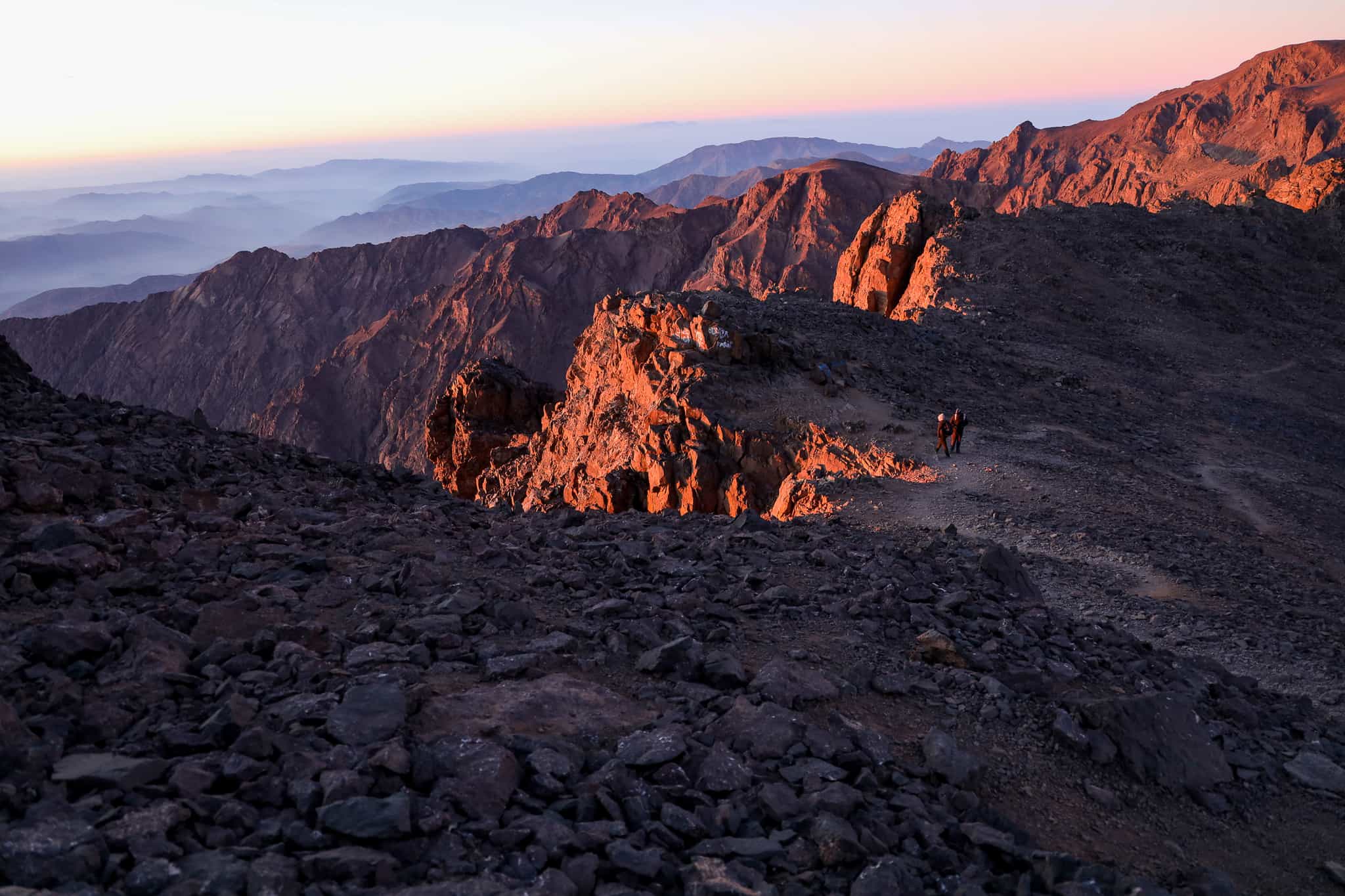
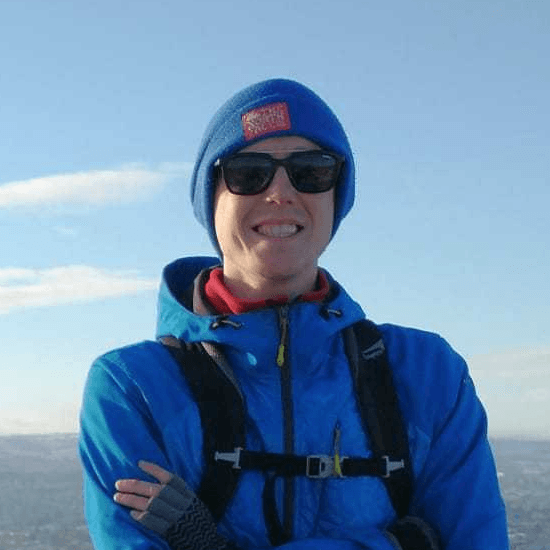
Need help finding flights?
From logistics and how to get there, to fitness, group dynamic and trip difficulty, Rory and his team of friendly experts are on hand to help.
We've got your back
Guaranteed to run
All Much Better Adventures trips are now guaranteed to run. Once you’ve booked your spot you can immediately make your travel arrangements, no uncertainty, no hanging about (excludes 'request to book' departures). Full details
Flexible payments
Secure your spot with the minimum deposit and pay off the remaining balance in as many instalments as you like, with no interest or fees. Full details
Happiness Guarantee
We’re so confident you’ll have an amazing time we’ll put our money on it. Full details
Full financial protection
To give you complete peace of mind Much Better Adventures is backed by ABTOT, ABTA and ATOL memberships. Full details
Tried & Trusted
Much Better Adventures is consistently rated ‘Excellent’ on Trustpilot with over 1000 verified trip reviews.
Connect before you go
You'll be invited to join a WhatsApp group to get to know each other before your big adventure together. Full details
DEPARTURE DATES
Wednesday 13th May 2026
to Sunday 24th May 2026
2026 Early Bird Sale Offer - Next 1 spot available at 10% off





